Motivation and Leadership
VerifiedAdded on 2019/11/14
|24
|6921
|252
Report
AI Summary
The provided content is a collection of academic articles, books, and studies on various topics related to motivation and organizational behavior. The papers explore theories such as Maslow's Hierarchy of Needs, Herzberg's Motivation-Hygiene Theory, McGregor's Theory X/Y, and Vroom's Expectancy Theory, among others. The research focuses on understanding employee motivation, job performance, leadership styles, and organizational development. It also examines the impact of factors like stress, self-actualization, and cultural values on individual and organizational behavior.
Contribute Materials
Your contribution can guide someone’s learning journey. Share your
documents today.
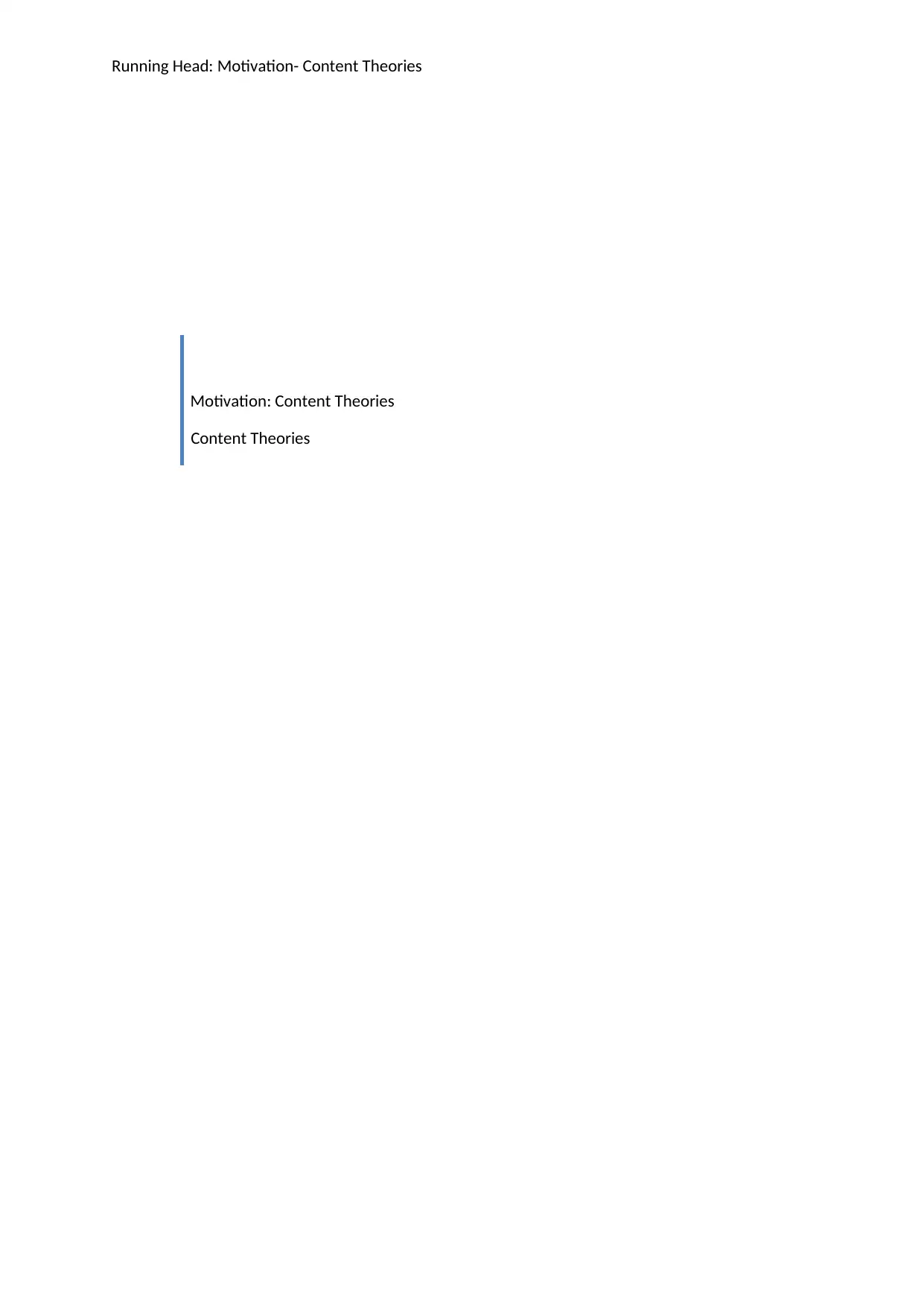
Running Head: Motivation- Content Theories
Motivation: Content Theories
Content Theories
Motivation: Content Theories
Content Theories
Secure Best Marks with AI Grader
Need help grading? Try our AI Grader for instant feedback on your assignments.
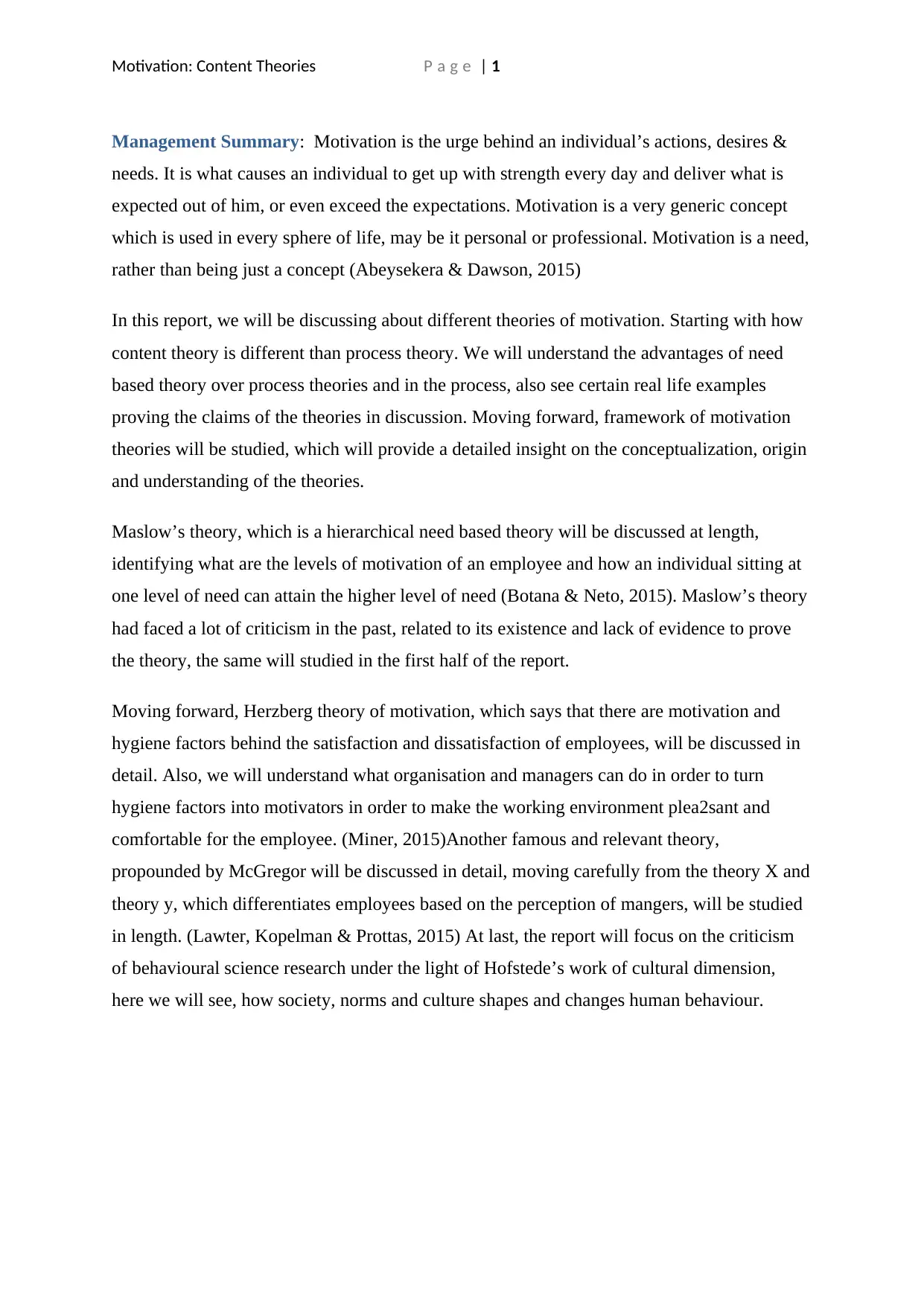
Motivation: Content Theories P a g e | 1
Management Summary: Motivation is the urge behind an individual’s actions, desires &
needs. It is what causes an individual to get up with strength every day and deliver what is
expected out of him, or even exceed the expectations. Motivation is a very generic concept
which is used in every sphere of life, may be it personal or professional. Motivation is a need,
rather than being just a concept (Abeysekera & Dawson, 2015)
In this report, we will be discussing about different theories of motivation. Starting with how
content theory is different than process theory. We will understand the advantages of need
based theory over process theories and in the process, also see certain real life examples
proving the claims of the theories in discussion. Moving forward, framework of motivation
theories will be studied, which will provide a detailed insight on the conceptualization, origin
and understanding of the theories.
Maslow’s theory, which is a hierarchical need based theory will be discussed at length,
identifying what are the levels of motivation of an employee and how an individual sitting at
one level of need can attain the higher level of need (Botana & Neto, 2015). Maslow’s theory
had faced a lot of criticism in the past, related to its existence and lack of evidence to prove
the theory, the same will studied in the first half of the report.
Moving forward, Herzberg theory of motivation, which says that there are motivation and
hygiene factors behind the satisfaction and dissatisfaction of employees, will be discussed in
detail. Also, we will understand what organisation and managers can do in order to turn
hygiene factors into motivators in order to make the working environment plea2sant and
comfortable for the employee. (Miner, 2015)Another famous and relevant theory,
propounded by McGregor will be discussed in detail, moving carefully from the theory X and
theory y, which differentiates employees based on the perception of mangers, will be studied
in length. (Lawter, Kopelman & Prottas, 2015) At last, the report will focus on the criticism
of behavioural science research under the light of Hofstede’s work of cultural dimension,
here we will see, how society, norms and culture shapes and changes human behaviour.
Management Summary: Motivation is the urge behind an individual’s actions, desires &
needs. It is what causes an individual to get up with strength every day and deliver what is
expected out of him, or even exceed the expectations. Motivation is a very generic concept
which is used in every sphere of life, may be it personal or professional. Motivation is a need,
rather than being just a concept (Abeysekera & Dawson, 2015)
In this report, we will be discussing about different theories of motivation. Starting with how
content theory is different than process theory. We will understand the advantages of need
based theory over process theories and in the process, also see certain real life examples
proving the claims of the theories in discussion. Moving forward, framework of motivation
theories will be studied, which will provide a detailed insight on the conceptualization, origin
and understanding of the theories.
Maslow’s theory, which is a hierarchical need based theory will be discussed at length,
identifying what are the levels of motivation of an employee and how an individual sitting at
one level of need can attain the higher level of need (Botana & Neto, 2015). Maslow’s theory
had faced a lot of criticism in the past, related to its existence and lack of evidence to prove
the theory, the same will studied in the first half of the report.
Moving forward, Herzberg theory of motivation, which says that there are motivation and
hygiene factors behind the satisfaction and dissatisfaction of employees, will be discussed in
detail. Also, we will understand what organisation and managers can do in order to turn
hygiene factors into motivators in order to make the working environment plea2sant and
comfortable for the employee. (Miner, 2015)Another famous and relevant theory,
propounded by McGregor will be discussed in detail, moving carefully from the theory X and
theory y, which differentiates employees based on the perception of mangers, will be studied
in length. (Lawter, Kopelman & Prottas, 2015) At last, the report will focus on the criticism
of behavioural science research under the light of Hofstede’s work of cultural dimension,
here we will see, how society, norms and culture shapes and changes human behaviour.
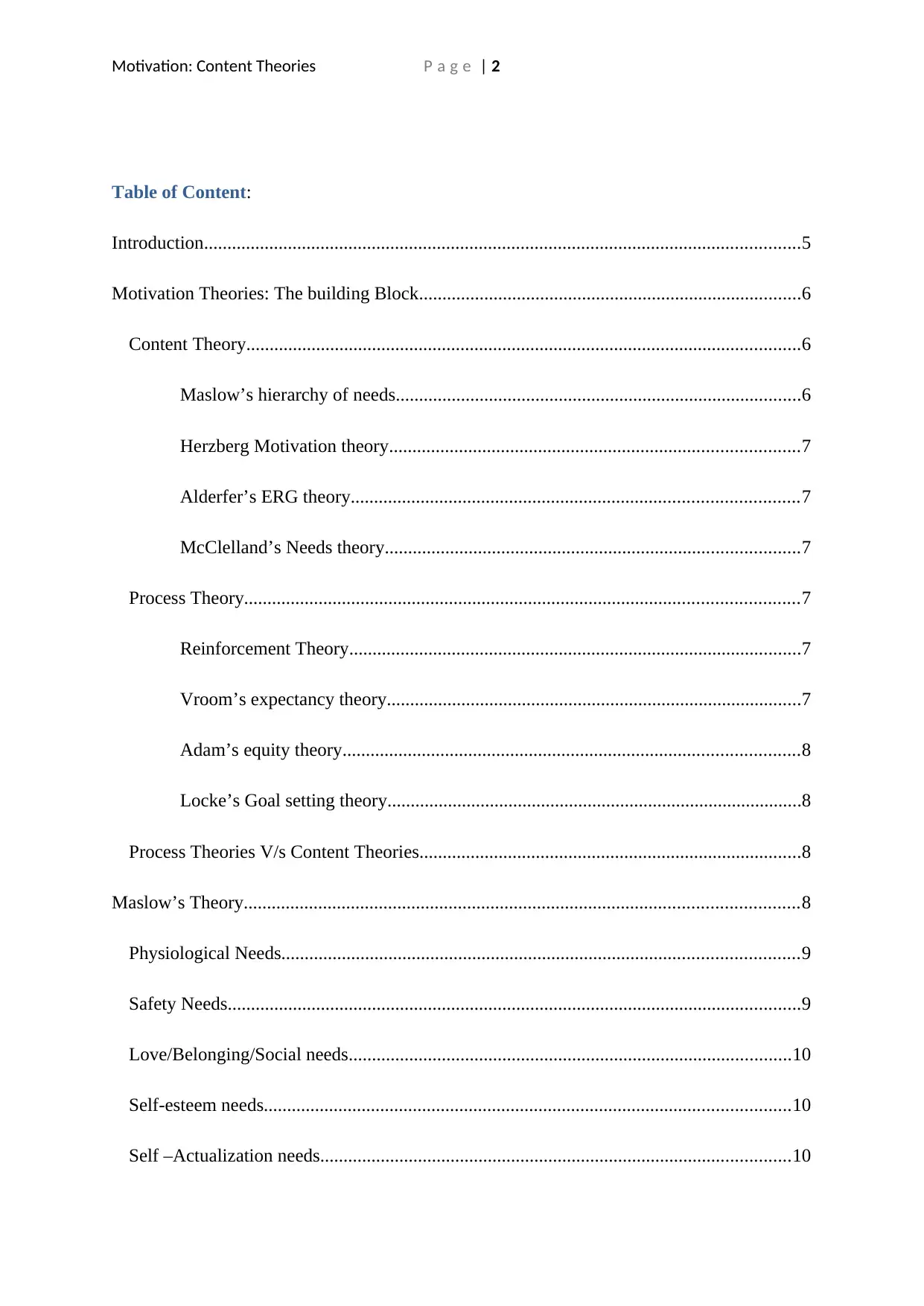
Motivation: Content Theories P a g e | 2
Table of Content:
Introduction................................................................................................................................5
Motivation Theories: The building Block..................................................................................6
Content Theory.......................................................................................................................6
Maslow’s hierarchy of needs.......................................................................................6
Herzberg Motivation theory........................................................................................7
Alderfer’s ERG theory................................................................................................7
McClelland’s Needs theory.........................................................................................7
Process Theory.......................................................................................................................7
Reinforcement Theory.................................................................................................7
Vroom’s expectancy theory.........................................................................................7
Adam’s equity theory..................................................................................................8
Locke’s Goal setting theory.........................................................................................8
Process Theories V/s Content Theories..................................................................................8
Maslow’s Theory.......................................................................................................................8
Physiological Needs...............................................................................................................9
Safety Needs...........................................................................................................................9
Love/Belonging/Social needs...............................................................................................10
Self-esteem needs.................................................................................................................10
Self –Actualization needs.....................................................................................................10
Table of Content:
Introduction................................................................................................................................5
Motivation Theories: The building Block..................................................................................6
Content Theory.......................................................................................................................6
Maslow’s hierarchy of needs.......................................................................................6
Herzberg Motivation theory........................................................................................7
Alderfer’s ERG theory................................................................................................7
McClelland’s Needs theory.........................................................................................7
Process Theory.......................................................................................................................7
Reinforcement Theory.................................................................................................7
Vroom’s expectancy theory.........................................................................................7
Adam’s equity theory..................................................................................................8
Locke’s Goal setting theory.........................................................................................8
Process Theories V/s Content Theories..................................................................................8
Maslow’s Theory.......................................................................................................................8
Physiological Needs...............................................................................................................9
Safety Needs...........................................................................................................................9
Love/Belonging/Social needs...............................................................................................10
Self-esteem needs.................................................................................................................10
Self –Actualization needs.....................................................................................................10
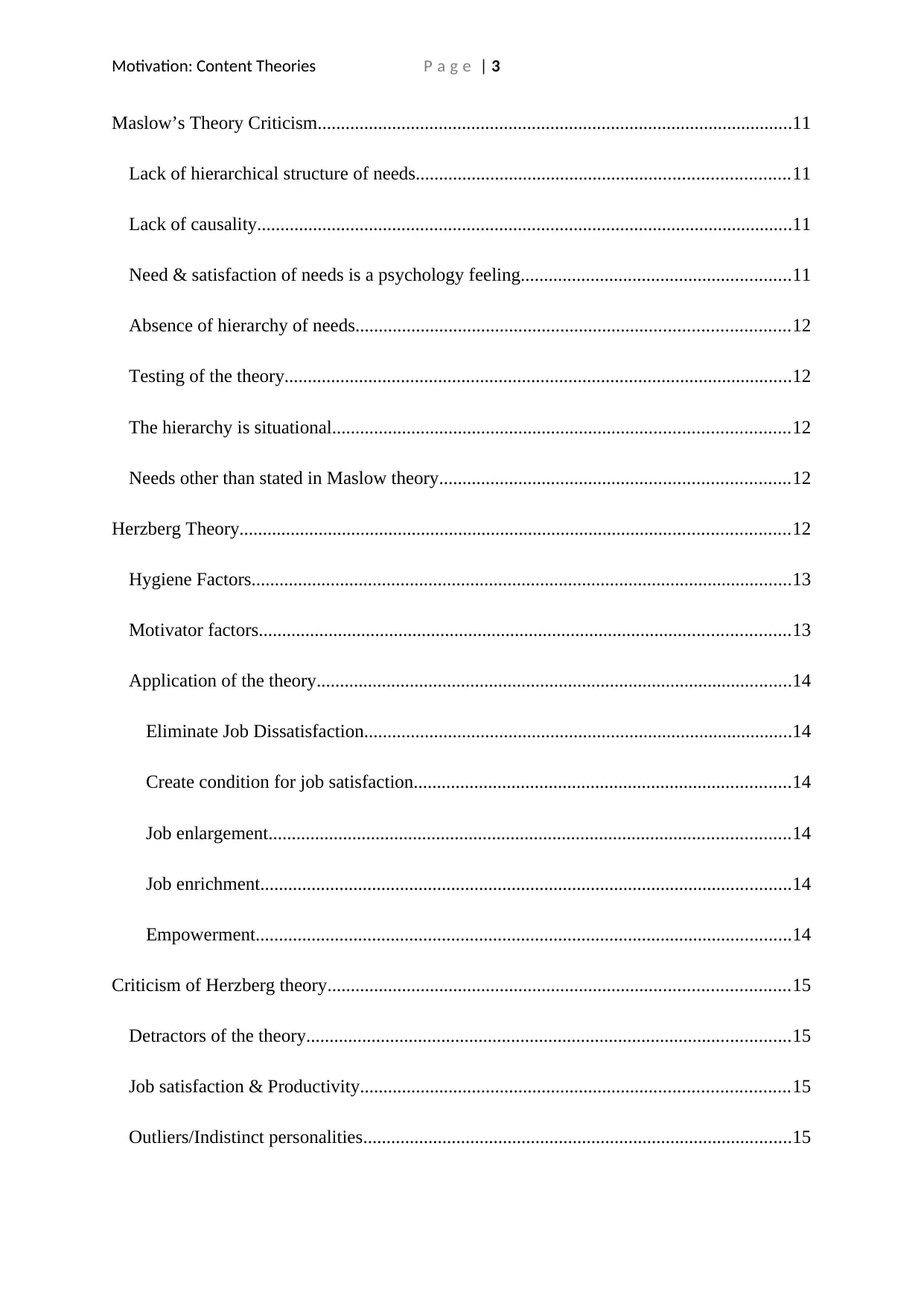
Motivation: Content Theories P a g e | 3
Maslow’s Theory Criticism......................................................................................................11
Lack of hierarchical structure of needs................................................................................11
Lack of causality...................................................................................................................11
Need & satisfaction of needs is a psychology feeling..........................................................11
Absence of hierarchy of needs.............................................................................................12
Testing of the theory.............................................................................................................12
The hierarchy is situational..................................................................................................12
Needs other than stated in Maslow theory...........................................................................12
Herzberg Theory......................................................................................................................12
Hygiene Factors....................................................................................................................13
Motivator factors..................................................................................................................13
Application of the theory......................................................................................................14
Eliminate Job Dissatisfaction............................................................................................14
Create condition for job satisfaction.................................................................................14
Job enlargement................................................................................................................14
Job enrichment..................................................................................................................14
Empowerment...................................................................................................................14
Criticism of Herzberg theory...................................................................................................15
Detractors of the theory........................................................................................................15
Job satisfaction & Productivity............................................................................................15
Outliers/Indistinct personalities............................................................................................15
Maslow’s Theory Criticism......................................................................................................11
Lack of hierarchical structure of needs................................................................................11
Lack of causality...................................................................................................................11
Need & satisfaction of needs is a psychology feeling..........................................................11
Absence of hierarchy of needs.............................................................................................12
Testing of the theory.............................................................................................................12
The hierarchy is situational..................................................................................................12
Needs other than stated in Maslow theory...........................................................................12
Herzberg Theory......................................................................................................................12
Hygiene Factors....................................................................................................................13
Motivator factors..................................................................................................................13
Application of the theory......................................................................................................14
Eliminate Job Dissatisfaction............................................................................................14
Create condition for job satisfaction.................................................................................14
Job enlargement................................................................................................................14
Job enrichment..................................................................................................................14
Empowerment...................................................................................................................14
Criticism of Herzberg theory...................................................................................................15
Detractors of the theory........................................................................................................15
Job satisfaction & Productivity............................................................................................15
Outliers/Indistinct personalities............................................................................................15
Secure Best Marks with AI Grader
Need help grading? Try our AI Grader for instant feedback on your assignments.
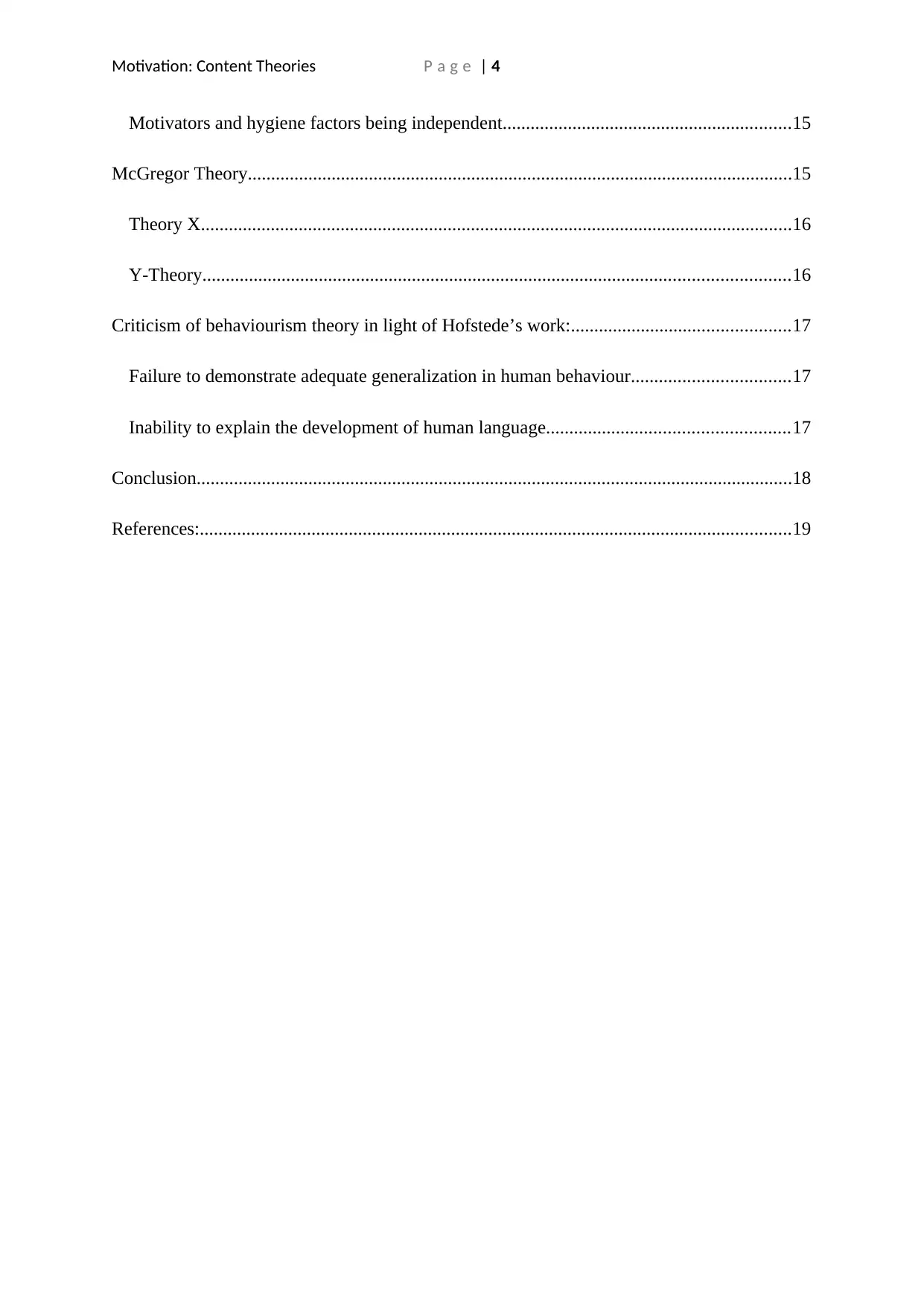
Motivation: Content Theories P a g e | 4
Motivators and hygiene factors being independent..............................................................15
McGregor Theory.....................................................................................................................15
Theory X...............................................................................................................................16
Y-Theory..............................................................................................................................16
Criticism of behaviourism theory in light of Hofstede’s work:...............................................17
Failure to demonstrate adequate generalization in human behaviour..................................17
Inability to explain the development of human language....................................................17
Conclusion................................................................................................................................18
References:...............................................................................................................................19
Motivators and hygiene factors being independent..............................................................15
McGregor Theory.....................................................................................................................15
Theory X...............................................................................................................................16
Y-Theory..............................................................................................................................16
Criticism of behaviourism theory in light of Hofstede’s work:...............................................17
Failure to demonstrate adequate generalization in human behaviour..................................17
Inability to explain the development of human language....................................................17
Conclusion................................................................................................................................18
References:...............................................................................................................................19
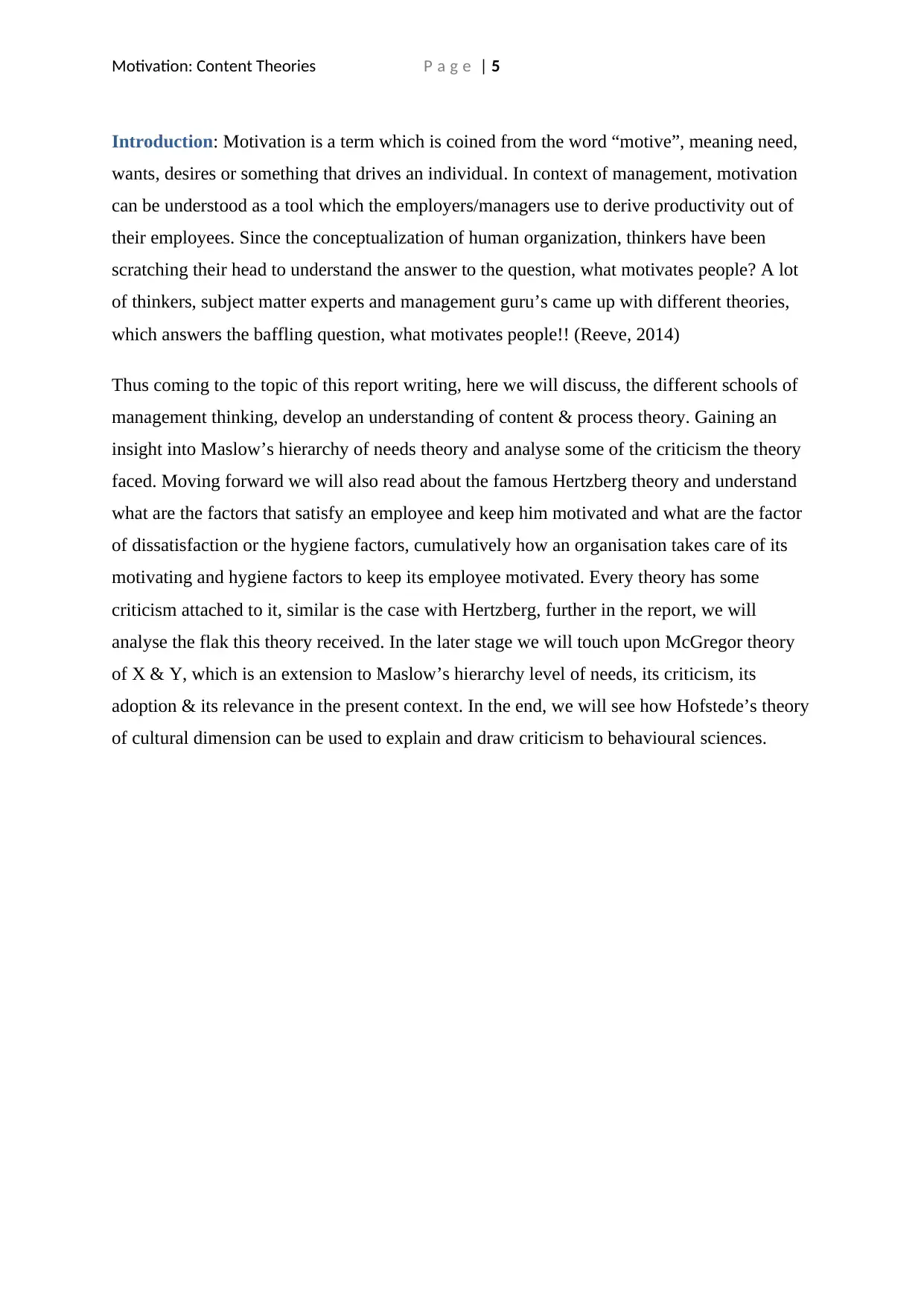
Motivation: Content Theories P a g e | 5
Introduction: Motivation is a term which is coined from the word “motive”, meaning need,
wants, desires or something that drives an individual. In context of management, motivation
can be understood as a tool which the employers/managers use to derive productivity out of
their employees. Since the conceptualization of human organization, thinkers have been
scratching their head to understand the answer to the question, what motivates people? A lot
of thinkers, subject matter experts and management guru’s came up with different theories,
which answers the baffling question, what motivates people!! (Reeve, 2014)
Thus coming to the topic of this report writing, here we will discuss, the different schools of
management thinking, develop an understanding of content & process theory. Gaining an
insight into Maslow’s hierarchy of needs theory and analyse some of the criticism the theory
faced. Moving forward we will also read about the famous Hertzberg theory and understand
what are the factors that satisfy an employee and keep him motivated and what are the factor
of dissatisfaction or the hygiene factors, cumulatively how an organisation takes care of its
motivating and hygiene factors to keep its employee motivated. Every theory has some
criticism attached to it, similar is the case with Hertzberg, further in the report, we will
analyse the flak this theory received. In the later stage we will touch upon McGregor theory
of X & Y, which is an extension to Maslow’s hierarchy level of needs, its criticism, its
adoption & its relevance in the present context. In the end, we will see how Hofstede’s theory
of cultural dimension can be used to explain and draw criticism to behavioural sciences.
Introduction: Motivation is a term which is coined from the word “motive”, meaning need,
wants, desires or something that drives an individual. In context of management, motivation
can be understood as a tool which the employers/managers use to derive productivity out of
their employees. Since the conceptualization of human organization, thinkers have been
scratching their head to understand the answer to the question, what motivates people? A lot
of thinkers, subject matter experts and management guru’s came up with different theories,
which answers the baffling question, what motivates people!! (Reeve, 2014)
Thus coming to the topic of this report writing, here we will discuss, the different schools of
management thinking, develop an understanding of content & process theory. Gaining an
insight into Maslow’s hierarchy of needs theory and analyse some of the criticism the theory
faced. Moving forward we will also read about the famous Hertzberg theory and understand
what are the factors that satisfy an employee and keep him motivated and what are the factor
of dissatisfaction or the hygiene factors, cumulatively how an organisation takes care of its
motivating and hygiene factors to keep its employee motivated. Every theory has some
criticism attached to it, similar is the case with Hertzberg, further in the report, we will
analyse the flak this theory received. In the later stage we will touch upon McGregor theory
of X & Y, which is an extension to Maslow’s hierarchy level of needs, its criticism, its
adoption & its relevance in the present context. In the end, we will see how Hofstede’s theory
of cultural dimension can be used to explain and draw criticism to behavioural sciences.
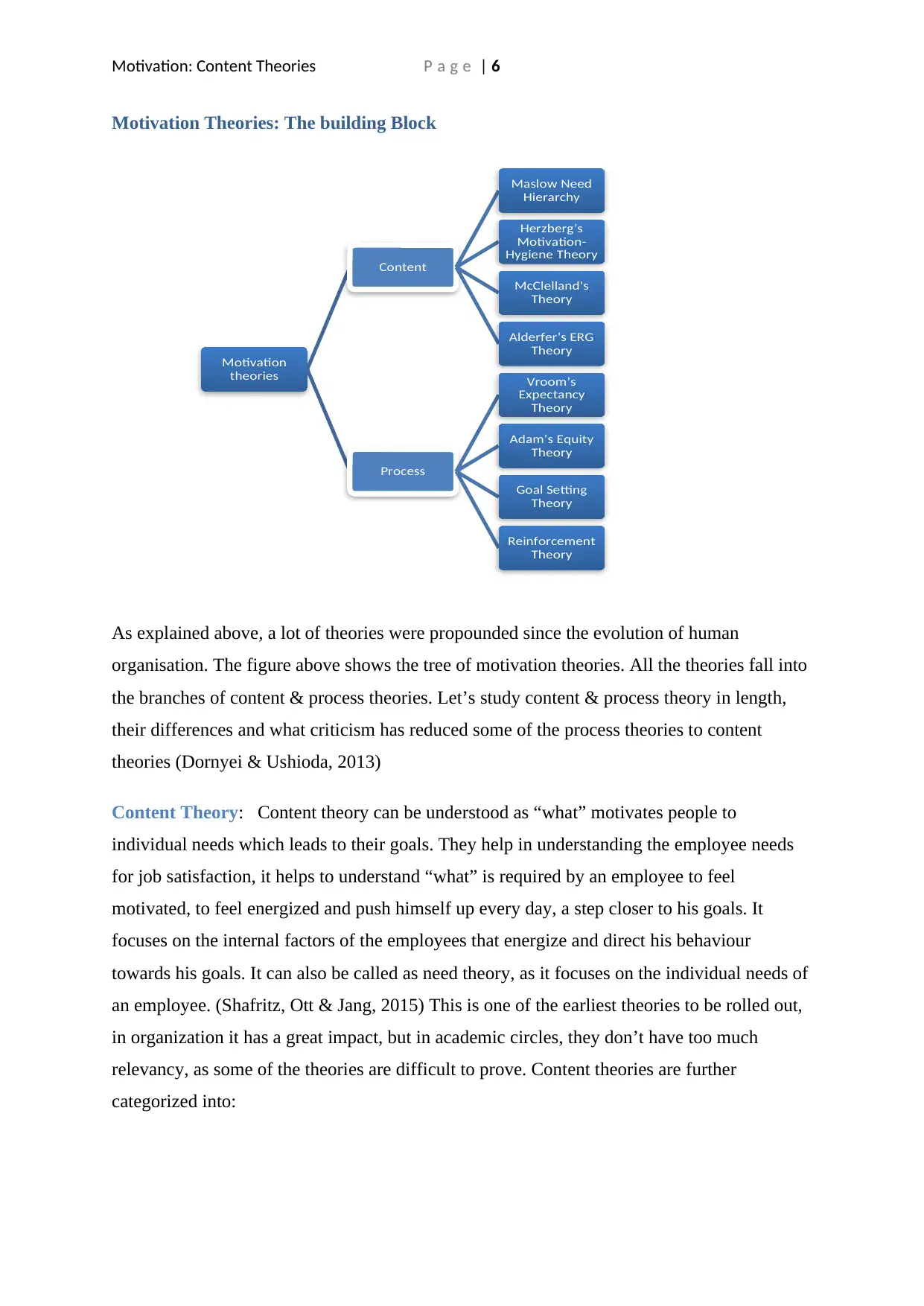
Motivation: Content Theories P a g e | 6
Motivation Theories: The building Block
As explained above, a lot of theories were propounded since the evolution of human
organisation. The figure above shows the tree of motivation theories. All the theories fall into
the branches of content & process theories. Let’s study content & process theory in length,
their differences and what criticism has reduced some of the process theories to content
theories (Dornyei & Ushioda, 2013)
Content Theory: Content theory can be understood as “what” motivates people to
individual needs which leads to their goals. They help in understanding the employee needs
for job satisfaction, it helps to understand “what” is required by an employee to feel
motivated, to feel energized and push himself up every day, a step closer to his goals. It
focuses on the internal factors of the employees that energize and direct his behaviour
towards his goals. It can also be called as need theory, as it focuses on the individual needs of
an employee. (Shafritz, Ott & Jang, 2015) This is one of the earliest theories to be rolled out,
in organization it has a great impact, but in academic circles, they don’t have too much
relevancy, as some of the theories are difficult to prove. Content theories are further
categorized into:
Motivation
theories
Content
Maslow Need
Hierarchy
Herzberg’s
Motivation-
Hygiene Theory
McClelland's
Theory
Alderfer’s ERG
Theory
Process
Vroom’s
Expectancy
Theory
Adam’s Equity
Theory
Goal Setting
Theory
Reinforcement
Theory
Motivation Theories: The building Block
As explained above, a lot of theories were propounded since the evolution of human
organisation. The figure above shows the tree of motivation theories. All the theories fall into
the branches of content & process theories. Let’s study content & process theory in length,
their differences and what criticism has reduced some of the process theories to content
theories (Dornyei & Ushioda, 2013)
Content Theory: Content theory can be understood as “what” motivates people to
individual needs which leads to their goals. They help in understanding the employee needs
for job satisfaction, it helps to understand “what” is required by an employee to feel
motivated, to feel energized and push himself up every day, a step closer to his goals. It
focuses on the internal factors of the employees that energize and direct his behaviour
towards his goals. It can also be called as need theory, as it focuses on the individual needs of
an employee. (Shafritz, Ott & Jang, 2015) This is one of the earliest theories to be rolled out,
in organization it has a great impact, but in academic circles, they don’t have too much
relevancy, as some of the theories are difficult to prove. Content theories are further
categorized into:
Motivation
theories
Content
Maslow Need
Hierarchy
Herzberg’s
Motivation-
Hygiene Theory
McClelland's
Theory
Alderfer’s ERG
Theory
Process
Vroom’s
Expectancy
Theory
Adam’s Equity
Theory
Goal Setting
Theory
Reinforcement
Theory
Paraphrase This Document
Need a fresh take? Get an instant paraphrase of this document with our AI Paraphraser
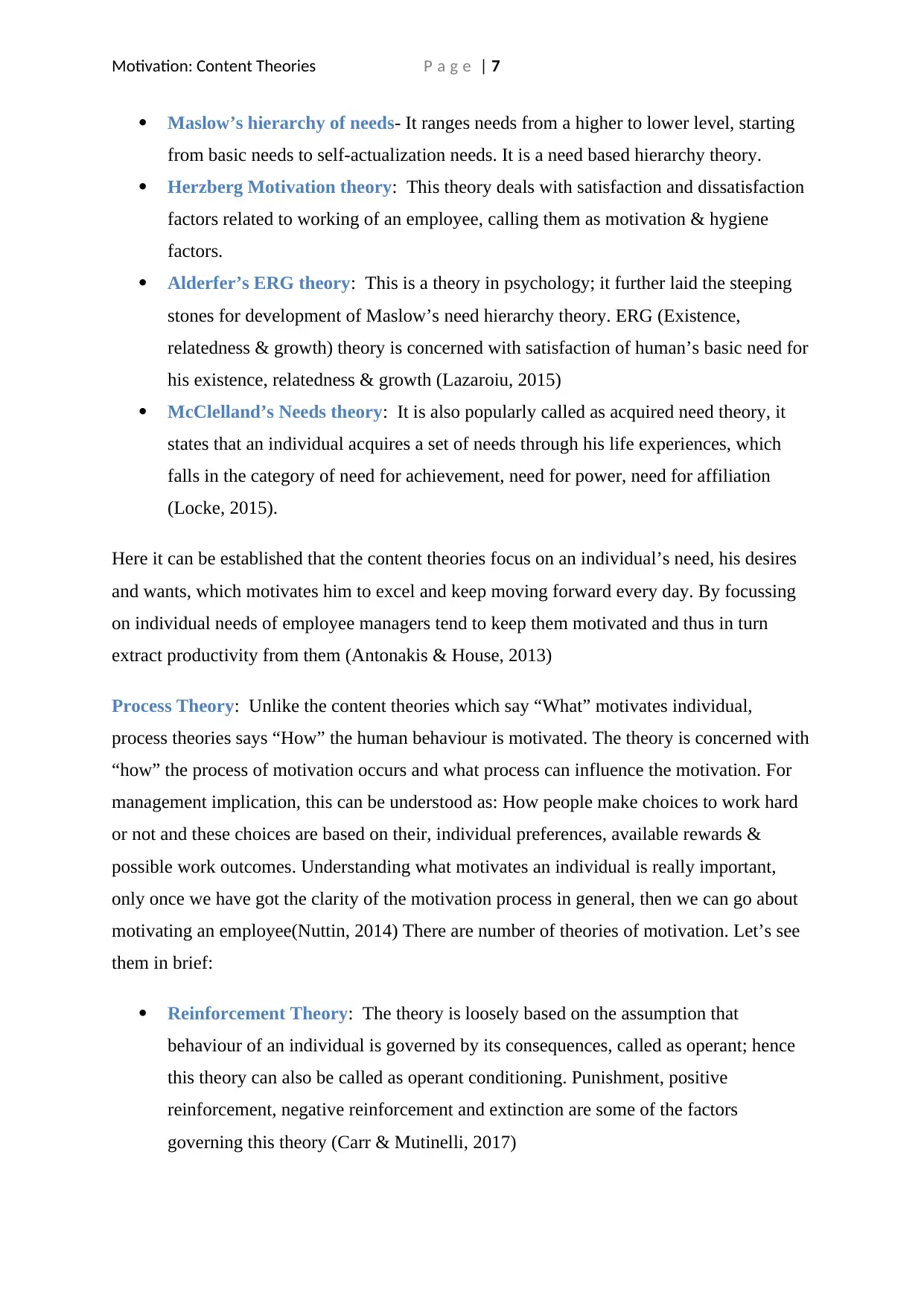
Motivation: Content Theories P a g e | 7
Maslow’s hierarchy of needs- It ranges needs from a higher to lower level, starting
from basic needs to self-actualization needs. It is a need based hierarchy theory.
Herzberg Motivation theory: This theory deals with satisfaction and dissatisfaction
factors related to working of an employee, calling them as motivation & hygiene
factors.
Alderfer’s ERG theory: This is a theory in psychology; it further laid the steeping
stones for development of Maslow’s need hierarchy theory. ERG (Existence,
relatedness & growth) theory is concerned with satisfaction of human’s basic need for
his existence, relatedness & growth (Lazaroiu, 2015)
McClelland’s Needs theory: It is also popularly called as acquired need theory, it
states that an individual acquires a set of needs through his life experiences, which
falls in the category of need for achievement, need for power, need for affiliation
(Locke, 2015).
Here it can be established that the content theories focus on an individual’s need, his desires
and wants, which motivates him to excel and keep moving forward every day. By focussing
on individual needs of employee managers tend to keep them motivated and thus in turn
extract productivity from them (Antonakis & House, 2013)
Process Theory: Unlike the content theories which say “What” motivates individual,
process theories says “How” the human behaviour is motivated. The theory is concerned with
“how” the process of motivation occurs and what process can influence the motivation. For
management implication, this can be understood as: How people make choices to work hard
or not and these choices are based on their, individual preferences, available rewards &
possible work outcomes. Understanding what motivates an individual is really important,
only once we have got the clarity of the motivation process in general, then we can go about
motivating an employee(Nuttin, 2014) There are number of theories of motivation. Let’s see
them in brief:
Reinforcement Theory: The theory is loosely based on the assumption that
behaviour of an individual is governed by its consequences, called as operant; hence
this theory can also be called as operant conditioning. Punishment, positive
reinforcement, negative reinforcement and extinction are some of the factors
governing this theory (Carr & Mutinelli, 2017)
Maslow’s hierarchy of needs- It ranges needs from a higher to lower level, starting
from basic needs to self-actualization needs. It is a need based hierarchy theory.
Herzberg Motivation theory: This theory deals with satisfaction and dissatisfaction
factors related to working of an employee, calling them as motivation & hygiene
factors.
Alderfer’s ERG theory: This is a theory in psychology; it further laid the steeping
stones for development of Maslow’s need hierarchy theory. ERG (Existence,
relatedness & growth) theory is concerned with satisfaction of human’s basic need for
his existence, relatedness & growth (Lazaroiu, 2015)
McClelland’s Needs theory: It is also popularly called as acquired need theory, it
states that an individual acquires a set of needs through his life experiences, which
falls in the category of need for achievement, need for power, need for affiliation
(Locke, 2015).
Here it can be established that the content theories focus on an individual’s need, his desires
and wants, which motivates him to excel and keep moving forward every day. By focussing
on individual needs of employee managers tend to keep them motivated and thus in turn
extract productivity from them (Antonakis & House, 2013)
Process Theory: Unlike the content theories which say “What” motivates individual,
process theories says “How” the human behaviour is motivated. The theory is concerned with
“how” the process of motivation occurs and what process can influence the motivation. For
management implication, this can be understood as: How people make choices to work hard
or not and these choices are based on their, individual preferences, available rewards &
possible work outcomes. Understanding what motivates an individual is really important,
only once we have got the clarity of the motivation process in general, then we can go about
motivating an employee(Nuttin, 2014) There are number of theories of motivation. Let’s see
them in brief:
Reinforcement Theory: The theory is loosely based on the assumption that
behaviour of an individual is governed by its consequences, called as operant; hence
this theory can also be called as operant conditioning. Punishment, positive
reinforcement, negative reinforcement and extinction are some of the factors
governing this theory (Carr & Mutinelli, 2017)
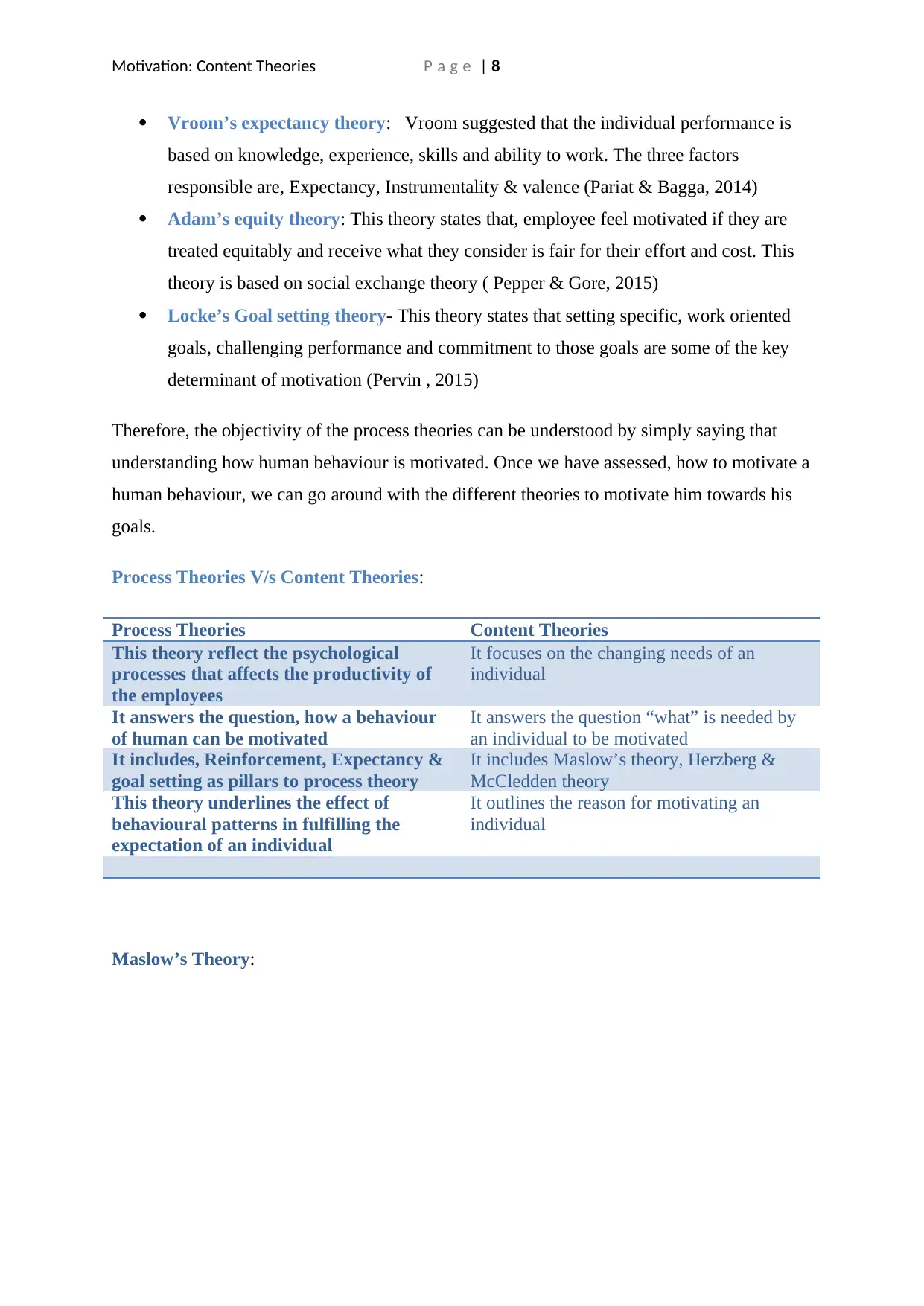
Motivation: Content Theories P a g e | 8
Vroom’s expectancy theory: Vroom suggested that the individual performance is
based on knowledge, experience, skills and ability to work. The three factors
responsible are, Expectancy, Instrumentality & valence (Pariat & Bagga, 2014)
Adam’s equity theory: This theory states that, employee feel motivated if they are
treated equitably and receive what they consider is fair for their effort and cost. This
theory is based on social exchange theory ( Pepper & Gore, 2015)
Locke’s Goal setting theory- This theory states that setting specific, work oriented
goals, challenging performance and commitment to those goals are some of the key
determinant of motivation (Pervin , 2015)
Therefore, the objectivity of the process theories can be understood by simply saying that
understanding how human behaviour is motivated. Once we have assessed, how to motivate a
human behaviour, we can go around with the different theories to motivate him towards his
goals.
Process Theories V/s Content Theories:
Process Theories Content Theories
This theory reflect the psychological
processes that affects the productivity of
the employees
It focuses on the changing needs of an
individual
It answers the question, how a behaviour
of human can be motivated
It answers the question “what” is needed by
an individual to be motivated
It includes, Reinforcement, Expectancy &
goal setting as pillars to process theory
It includes Maslow’s theory, Herzberg &
McCledden theory
This theory underlines the effect of
behavioural patterns in fulfilling the
expectation of an individual
It outlines the reason for motivating an
individual
Maslow’s Theory:
Vroom’s expectancy theory: Vroom suggested that the individual performance is
based on knowledge, experience, skills and ability to work. The three factors
responsible are, Expectancy, Instrumentality & valence (Pariat & Bagga, 2014)
Adam’s equity theory: This theory states that, employee feel motivated if they are
treated equitably and receive what they consider is fair for their effort and cost. This
theory is based on social exchange theory ( Pepper & Gore, 2015)
Locke’s Goal setting theory- This theory states that setting specific, work oriented
goals, challenging performance and commitment to those goals are some of the key
determinant of motivation (Pervin , 2015)
Therefore, the objectivity of the process theories can be understood by simply saying that
understanding how human behaviour is motivated. Once we have assessed, how to motivate a
human behaviour, we can go around with the different theories to motivate him towards his
goals.
Process Theories V/s Content Theories:
Process Theories Content Theories
This theory reflect the psychological
processes that affects the productivity of
the employees
It focuses on the changing needs of an
individual
It answers the question, how a behaviour
of human can be motivated
It answers the question “what” is needed by
an individual to be motivated
It includes, Reinforcement, Expectancy &
goal setting as pillars to process theory
It includes Maslow’s theory, Herzberg &
McCledden theory
This theory underlines the effect of
behavioural patterns in fulfilling the
expectation of an individual
It outlines the reason for motivating an
individual
Maslow’s Theory:
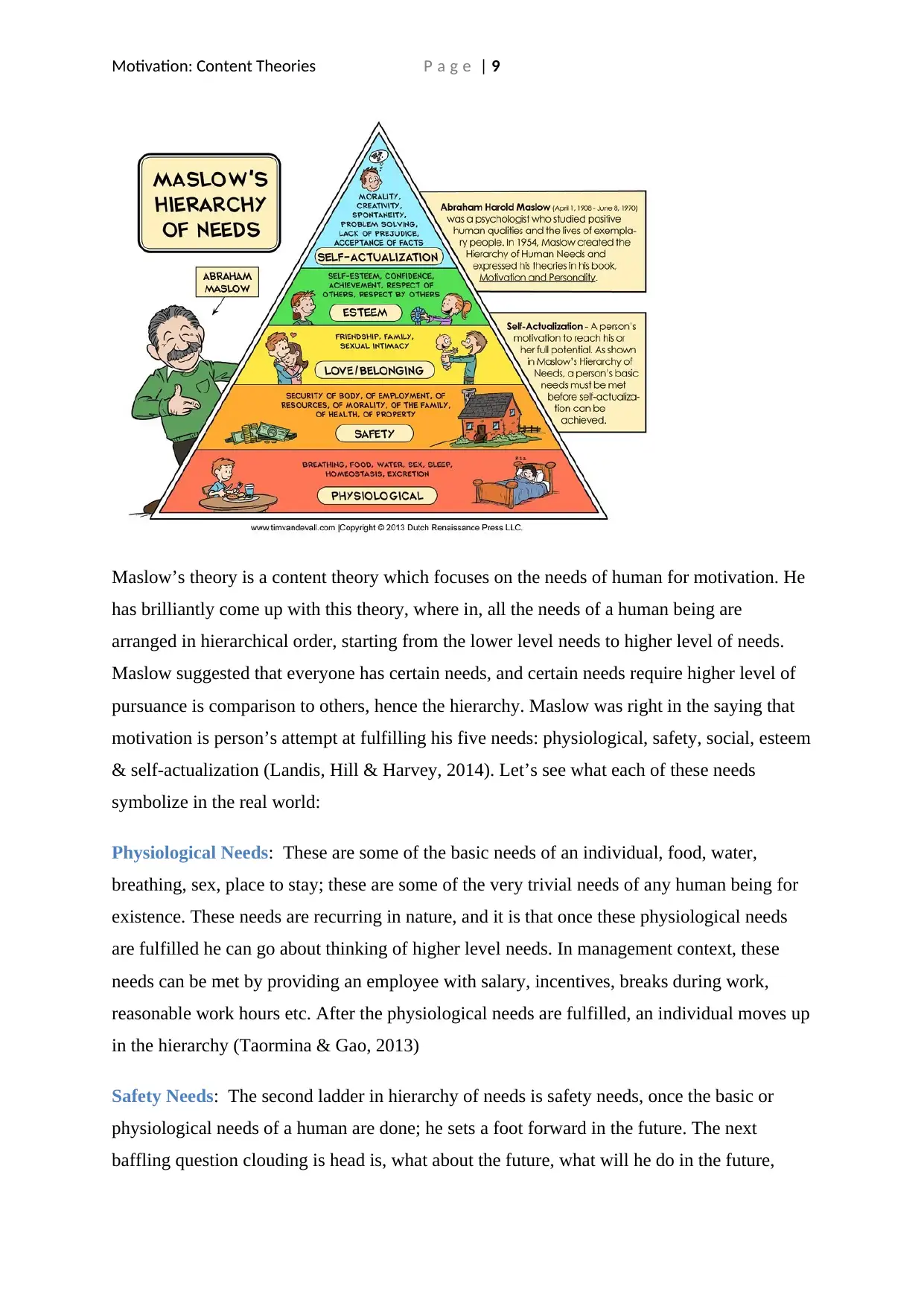
Motivation: Content Theories P a g e | 9
Maslow’s theory is a content theory which focuses on the needs of human for motivation. He
has brilliantly come up with this theory, where in, all the needs of a human being are
arranged in hierarchical order, starting from the lower level needs to higher level of needs.
Maslow suggested that everyone has certain needs, and certain needs require higher level of
pursuance is comparison to others, hence the hierarchy. Maslow was right in the saying that
motivation is person’s attempt at fulfilling his five needs: physiological, safety, social, esteem
& self-actualization (Landis, Hill & Harvey, 2014). Let’s see what each of these needs
symbolize in the real world:
Physiological Needs: These are some of the basic needs of an individual, food, water,
breathing, sex, place to stay; these are some of the very trivial needs of any human being for
existence. These needs are recurring in nature, and it is that once these physiological needs
are fulfilled he can go about thinking of higher level needs. In management context, these
needs can be met by providing an employee with salary, incentives, breaks during work,
reasonable work hours etc. After the physiological needs are fulfilled, an individual moves up
in the hierarchy (Taormina & Gao, 2013)
Safety Needs: The second ladder in hierarchy of needs is safety needs, once the basic or
physiological needs of a human are done; he sets a foot forward in the future. The next
baffling question clouding is head is, what about the future, what will he do in the future,
Maslow’s theory is a content theory which focuses on the needs of human for motivation. He
has brilliantly come up with this theory, where in, all the needs of a human being are
arranged in hierarchical order, starting from the lower level needs to higher level of needs.
Maslow suggested that everyone has certain needs, and certain needs require higher level of
pursuance is comparison to others, hence the hierarchy. Maslow was right in the saying that
motivation is person’s attempt at fulfilling his five needs: physiological, safety, social, esteem
& self-actualization (Landis, Hill & Harvey, 2014). Let’s see what each of these needs
symbolize in the real world:
Physiological Needs: These are some of the basic needs of an individual, food, water,
breathing, sex, place to stay; these are some of the very trivial needs of any human being for
existence. These needs are recurring in nature, and it is that once these physiological needs
are fulfilled he can go about thinking of higher level needs. In management context, these
needs can be met by providing an employee with salary, incentives, breaks during work,
reasonable work hours etc. After the physiological needs are fulfilled, an individual moves up
in the hierarchy (Taormina & Gao, 2013)
Safety Needs: The second ladder in hierarchy of needs is safety needs, once the basic or
physiological needs of a human are done; he sets a foot forward in the future. The next
baffling question clouding is head is, what about the future, what will he do in the future,
Secure Best Marks with AI Grader
Need help grading? Try our AI Grader for instant feedback on your assignments.
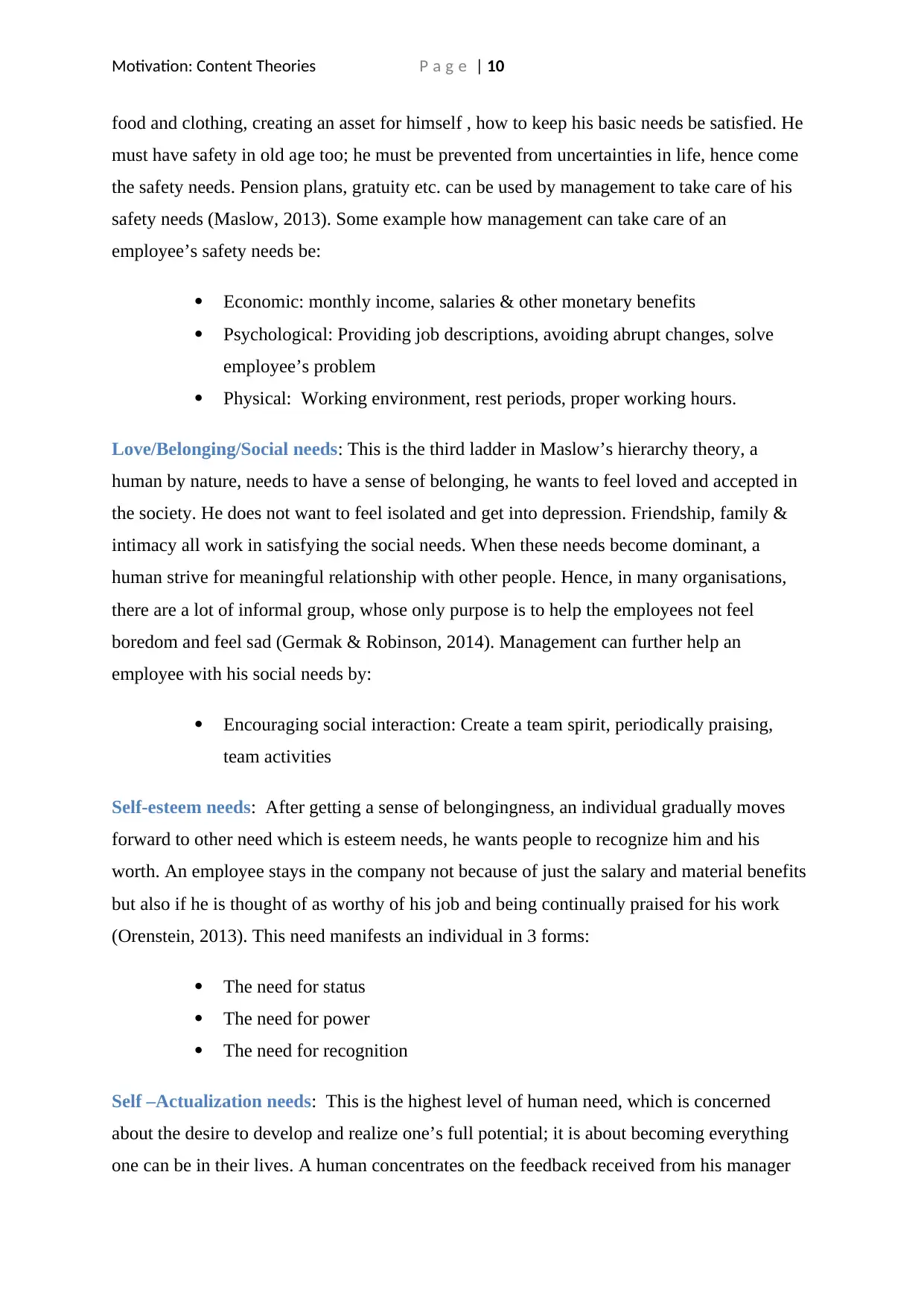
Motivation: Content Theories P a g e | 10
food and clothing, creating an asset for himself , how to keep his basic needs be satisfied. He
must have safety in old age too; he must be prevented from uncertainties in life, hence come
the safety needs. Pension plans, gratuity etc. can be used by management to take care of his
safety needs (Maslow, 2013). Some example how management can take care of an
employee’s safety needs be:
Economic: monthly income, salaries & other monetary benefits
Psychological: Providing job descriptions, avoiding abrupt changes, solve
employee’s problem
Physical: Working environment, rest periods, proper working hours.
Love/Belonging/Social needs: This is the third ladder in Maslow’s hierarchy theory, a
human by nature, needs to have a sense of belonging, he wants to feel loved and accepted in
the society. He does not want to feel isolated and get into depression. Friendship, family &
intimacy all work in satisfying the social needs. When these needs become dominant, a
human strive for meaningful relationship with other people. Hence, in many organisations,
there are a lot of informal group, whose only purpose is to help the employees not feel
boredom and feel sad (Germak & Robinson, 2014). Management can further help an
employee with his social needs by:
Encouraging social interaction: Create a team spirit, periodically praising,
team activities
Self-esteem needs: After getting a sense of belongingness, an individual gradually moves
forward to other need which is esteem needs, he wants people to recognize him and his
worth. An employee stays in the company not because of just the salary and material benefits
but also if he is thought of as worthy of his job and being continually praised for his work
(Orenstein, 2013). This need manifests an individual in 3 forms:
The need for status
The need for power
The need for recognition
Self –Actualization needs: This is the highest level of human need, which is concerned
about the desire to develop and realize one’s full potential; it is about becoming everything
one can be in their lives. A human concentrates on the feedback received from his manager
food and clothing, creating an asset for himself , how to keep his basic needs be satisfied. He
must have safety in old age too; he must be prevented from uncertainties in life, hence come
the safety needs. Pension plans, gratuity etc. can be used by management to take care of his
safety needs (Maslow, 2013). Some example how management can take care of an
employee’s safety needs be:
Economic: monthly income, salaries & other monetary benefits
Psychological: Providing job descriptions, avoiding abrupt changes, solve
employee’s problem
Physical: Working environment, rest periods, proper working hours.
Love/Belonging/Social needs: This is the third ladder in Maslow’s hierarchy theory, a
human by nature, needs to have a sense of belonging, he wants to feel loved and accepted in
the society. He does not want to feel isolated and get into depression. Friendship, family &
intimacy all work in satisfying the social needs. When these needs become dominant, a
human strive for meaningful relationship with other people. Hence, in many organisations,
there are a lot of informal group, whose only purpose is to help the employees not feel
boredom and feel sad (Germak & Robinson, 2014). Management can further help an
employee with his social needs by:
Encouraging social interaction: Create a team spirit, periodically praising,
team activities
Self-esteem needs: After getting a sense of belongingness, an individual gradually moves
forward to other need which is esteem needs, he wants people to recognize him and his
worth. An employee stays in the company not because of just the salary and material benefits
but also if he is thought of as worthy of his job and being continually praised for his work
(Orenstein, 2013). This need manifests an individual in 3 forms:
The need for status
The need for power
The need for recognition
Self –Actualization needs: This is the highest level of human need, which is concerned
about the desire to develop and realize one’s full potential; it is about becoming everything
one can be in their lives. A human concentrates on the feedback received from his manager
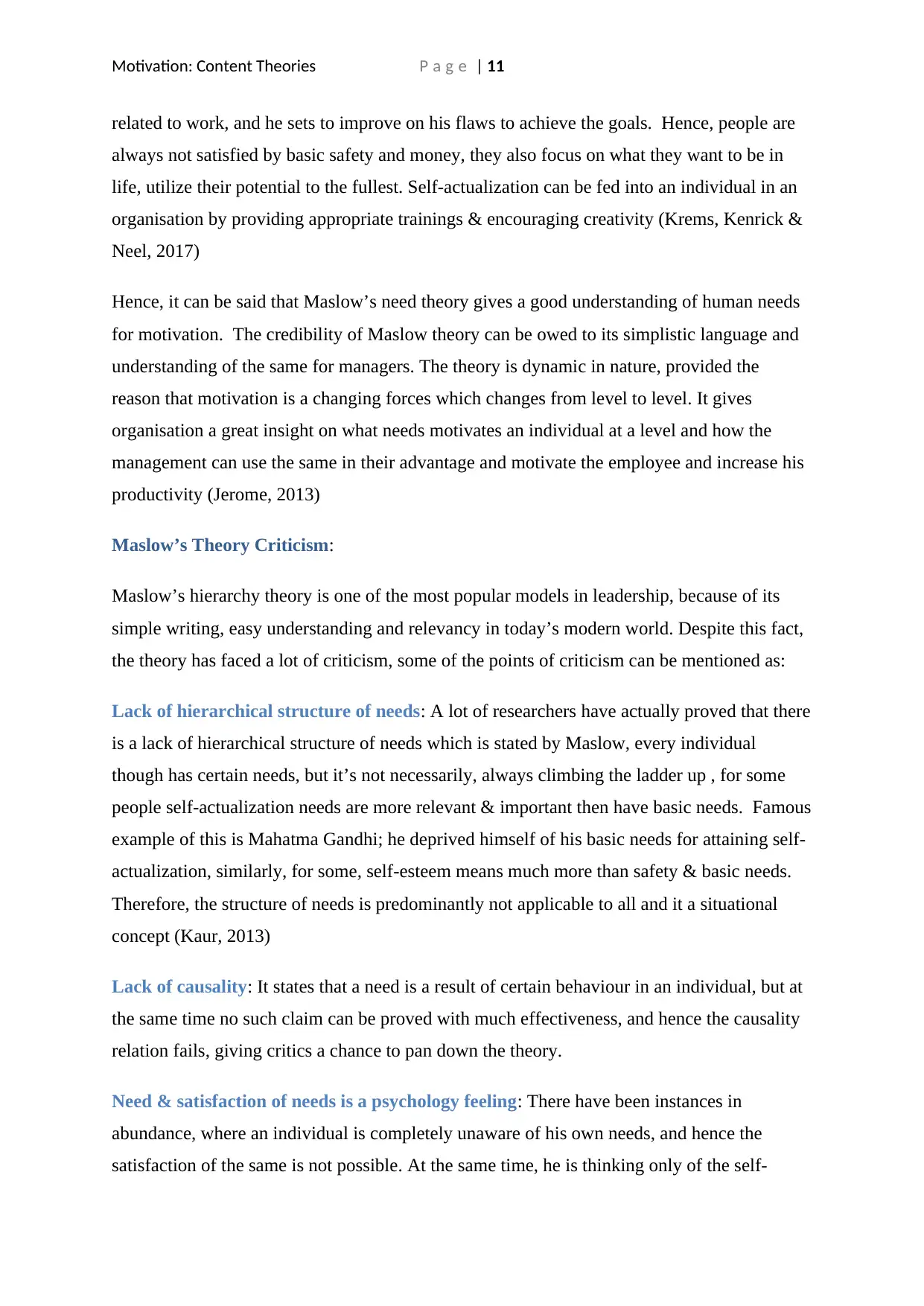
Motivation: Content Theories P a g e | 11
related to work, and he sets to improve on his flaws to achieve the goals. Hence, people are
always not satisfied by basic safety and money, they also focus on what they want to be in
life, utilize their potential to the fullest. Self-actualization can be fed into an individual in an
organisation by providing appropriate trainings & encouraging creativity (Krems, Kenrick &
Neel, 2017)
Hence, it can be said that Maslow’s need theory gives a good understanding of human needs
for motivation. The credibility of Maslow theory can be owed to its simplistic language and
understanding of the same for managers. The theory is dynamic in nature, provided the
reason that motivation is a changing forces which changes from level to level. It gives
organisation a great insight on what needs motivates an individual at a level and how the
management can use the same in their advantage and motivate the employee and increase his
productivity (Jerome, 2013)
Maslow’s Theory Criticism:
Maslow’s hierarchy theory is one of the most popular models in leadership, because of its
simple writing, easy understanding and relevancy in today’s modern world. Despite this fact,
the theory has faced a lot of criticism, some of the points of criticism can be mentioned as:
Lack of hierarchical structure of needs: A lot of researchers have actually proved that there
is a lack of hierarchical structure of needs which is stated by Maslow, every individual
though has certain needs, but it’s not necessarily, always climbing the ladder up , for some
people self-actualization needs are more relevant & important then have basic needs. Famous
example of this is Mahatma Gandhi; he deprived himself of his basic needs for attaining self-
actualization, similarly, for some, self-esteem means much more than safety & basic needs.
Therefore, the structure of needs is predominantly not applicable to all and it a situational
concept (Kaur, 2013)
Lack of causality: It states that a need is a result of certain behaviour in an individual, but at
the same time no such claim can be proved with much effectiveness, and hence the causality
relation fails, giving critics a chance to pan down the theory.
Need & satisfaction of needs is a psychology feeling: There have been instances in
abundance, where an individual is completely unaware of his own needs, and hence the
satisfaction of the same is not possible. At the same time, he is thinking only of the self-
related to work, and he sets to improve on his flaws to achieve the goals. Hence, people are
always not satisfied by basic safety and money, they also focus on what they want to be in
life, utilize their potential to the fullest. Self-actualization can be fed into an individual in an
organisation by providing appropriate trainings & encouraging creativity (Krems, Kenrick &
Neel, 2017)
Hence, it can be said that Maslow’s need theory gives a good understanding of human needs
for motivation. The credibility of Maslow theory can be owed to its simplistic language and
understanding of the same for managers. The theory is dynamic in nature, provided the
reason that motivation is a changing forces which changes from level to level. It gives
organisation a great insight on what needs motivates an individual at a level and how the
management can use the same in their advantage and motivate the employee and increase his
productivity (Jerome, 2013)
Maslow’s Theory Criticism:
Maslow’s hierarchy theory is one of the most popular models in leadership, because of its
simple writing, easy understanding and relevancy in today’s modern world. Despite this fact,
the theory has faced a lot of criticism, some of the points of criticism can be mentioned as:
Lack of hierarchical structure of needs: A lot of researchers have actually proved that there
is a lack of hierarchical structure of needs which is stated by Maslow, every individual
though has certain needs, but it’s not necessarily, always climbing the ladder up , for some
people self-actualization needs are more relevant & important then have basic needs. Famous
example of this is Mahatma Gandhi; he deprived himself of his basic needs for attaining self-
actualization, similarly, for some, self-esteem means much more than safety & basic needs.
Therefore, the structure of needs is predominantly not applicable to all and it a situational
concept (Kaur, 2013)
Lack of causality: It states that a need is a result of certain behaviour in an individual, but at
the same time no such claim can be proved with much effectiveness, and hence the causality
relation fails, giving critics a chance to pan down the theory.
Need & satisfaction of needs is a psychology feeling: There have been instances in
abundance, where an individual is completely unaware of his own needs, and hence the
satisfaction of the same is not possible. At the same time, he is thinking only of the self-
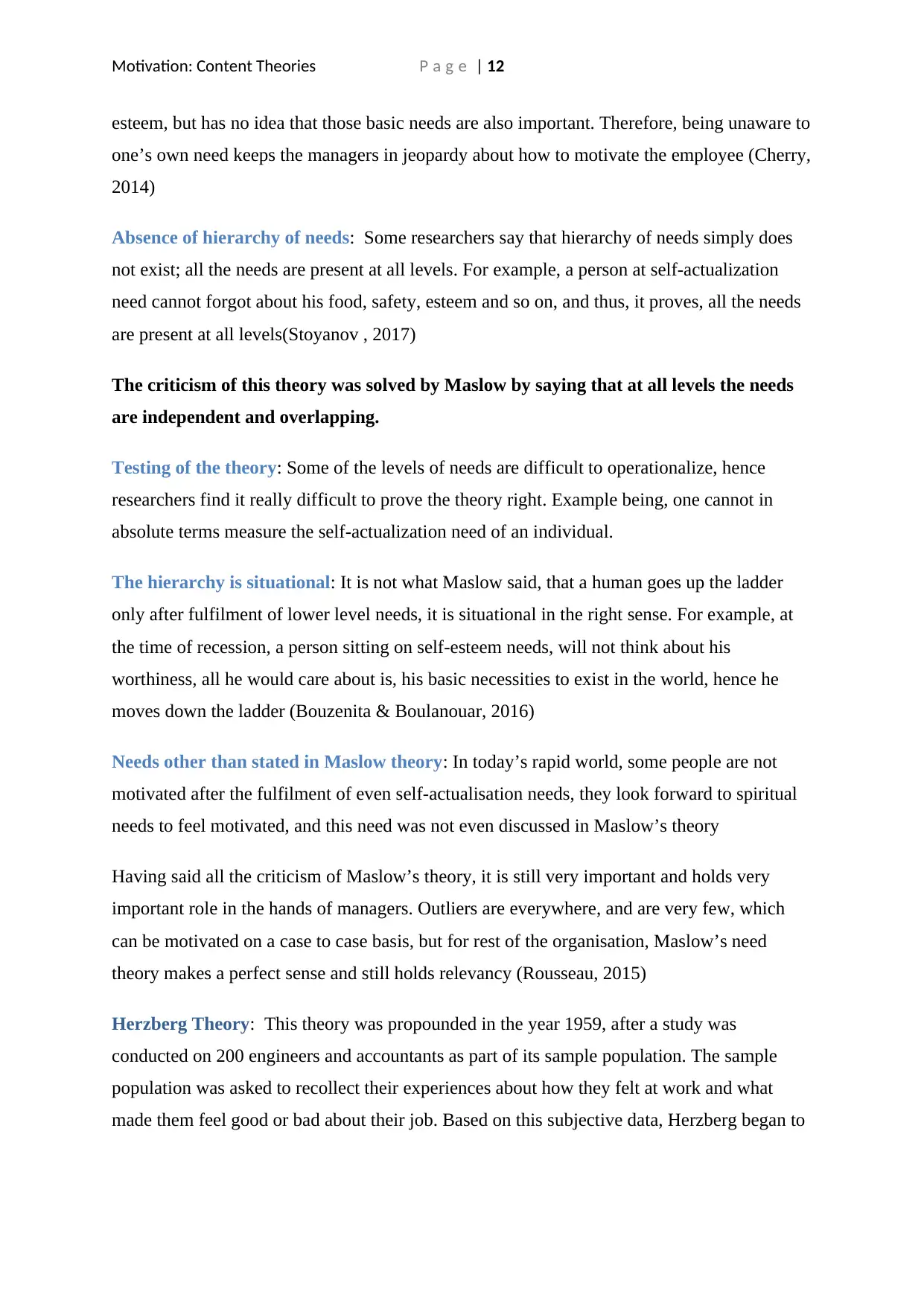
Motivation: Content Theories P a g e | 12
esteem, but has no idea that those basic needs are also important. Therefore, being unaware to
one’s own need keeps the managers in jeopardy about how to motivate the employee (Cherry,
2014)
Absence of hierarchy of needs: Some researchers say that hierarchy of needs simply does
not exist; all the needs are present at all levels. For example, a person at self-actualization
need cannot forgot about his food, safety, esteem and so on, and thus, it proves, all the needs
are present at all levels(Stoyanov , 2017)
The criticism of this theory was solved by Maslow by saying that at all levels the needs
are independent and overlapping.
Testing of the theory: Some of the levels of needs are difficult to operationalize, hence
researchers find it really difficult to prove the theory right. Example being, one cannot in
absolute terms measure the self-actualization need of an individual.
The hierarchy is situational: It is not what Maslow said, that a human goes up the ladder
only after fulfilment of lower level needs, it is situational in the right sense. For example, at
the time of recession, a person sitting on self-esteem needs, will not think about his
worthiness, all he would care about is, his basic necessities to exist in the world, hence he
moves down the ladder (Bouzenita & Boulanouar, 2016)
Needs other than stated in Maslow theory: In today’s rapid world, some people are not
motivated after the fulfilment of even self-actualisation needs, they look forward to spiritual
needs to feel motivated, and this need was not even discussed in Maslow’s theory
Having said all the criticism of Maslow’s theory, it is still very important and holds very
important role in the hands of managers. Outliers are everywhere, and are very few, which
can be motivated on a case to case basis, but for rest of the organisation, Maslow’s need
theory makes a perfect sense and still holds relevancy (Rousseau, 2015)
Herzberg Theory: This theory was propounded in the year 1959, after a study was
conducted on 200 engineers and accountants as part of its sample population. The sample
population was asked to recollect their experiences about how they felt at work and what
made them feel good or bad about their job. Based on this subjective data, Herzberg began to
esteem, but has no idea that those basic needs are also important. Therefore, being unaware to
one’s own need keeps the managers in jeopardy about how to motivate the employee (Cherry,
2014)
Absence of hierarchy of needs: Some researchers say that hierarchy of needs simply does
not exist; all the needs are present at all levels. For example, a person at self-actualization
need cannot forgot about his food, safety, esteem and so on, and thus, it proves, all the needs
are present at all levels(Stoyanov , 2017)
The criticism of this theory was solved by Maslow by saying that at all levels the needs
are independent and overlapping.
Testing of the theory: Some of the levels of needs are difficult to operationalize, hence
researchers find it really difficult to prove the theory right. Example being, one cannot in
absolute terms measure the self-actualization need of an individual.
The hierarchy is situational: It is not what Maslow said, that a human goes up the ladder
only after fulfilment of lower level needs, it is situational in the right sense. For example, at
the time of recession, a person sitting on self-esteem needs, will not think about his
worthiness, all he would care about is, his basic necessities to exist in the world, hence he
moves down the ladder (Bouzenita & Boulanouar, 2016)
Needs other than stated in Maslow theory: In today’s rapid world, some people are not
motivated after the fulfilment of even self-actualisation needs, they look forward to spiritual
needs to feel motivated, and this need was not even discussed in Maslow’s theory
Having said all the criticism of Maslow’s theory, it is still very important and holds very
important role in the hands of managers. Outliers are everywhere, and are very few, which
can be motivated on a case to case basis, but for rest of the organisation, Maslow’s need
theory makes a perfect sense and still holds relevancy (Rousseau, 2015)
Herzberg Theory: This theory was propounded in the year 1959, after a study was
conducted on 200 engineers and accountants as part of its sample population. The sample
population was asked to recollect their experiences about how they felt at work and what
made them feel good or bad about their job. Based on this subjective data, Herzberg began to
Paraphrase This Document
Need a fresh take? Get an instant paraphrase of this document with our AI Paraphraser
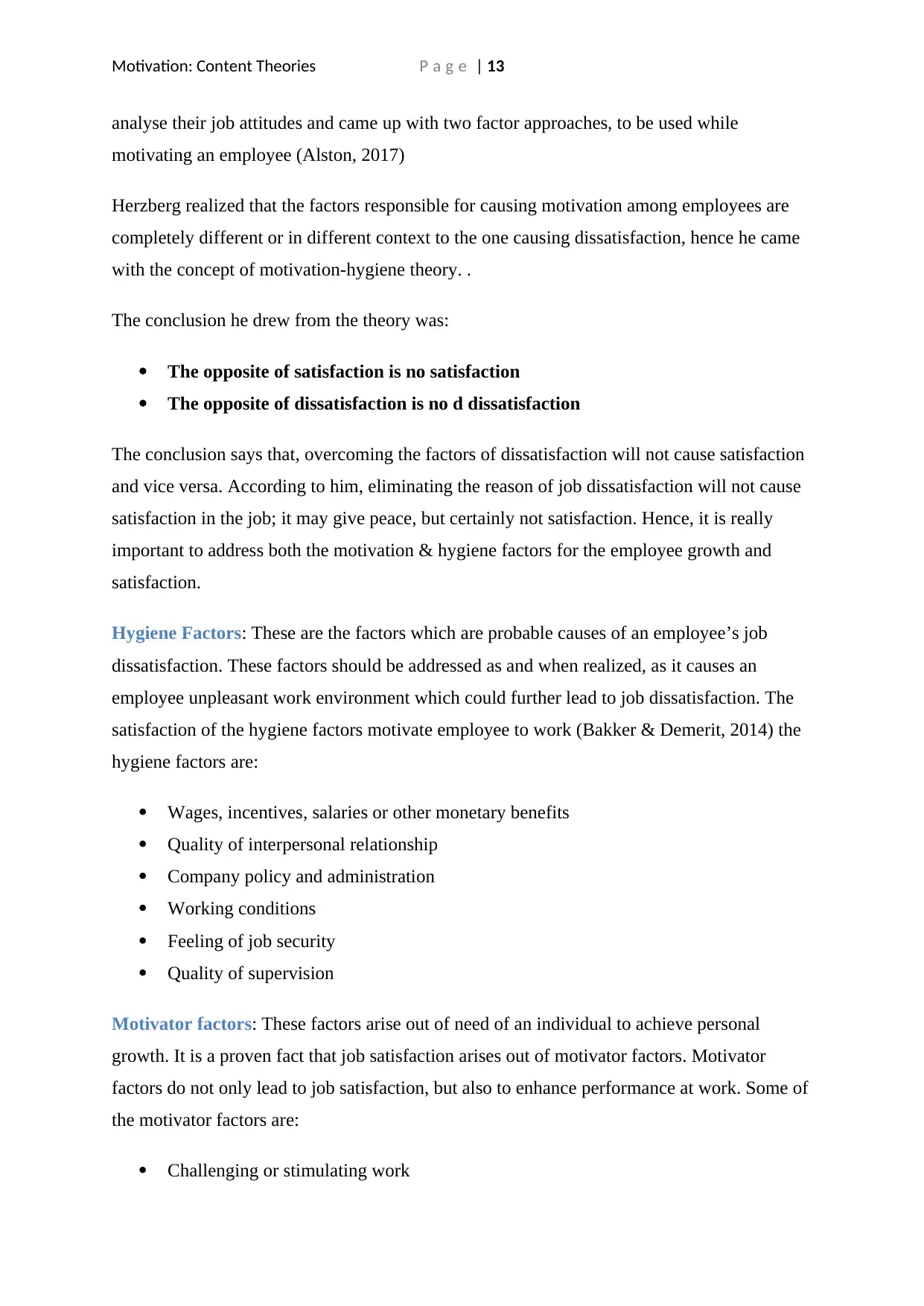
Motivation: Content Theories P a g e | 13
analyse their job attitudes and came up with two factor approaches, to be used while
motivating an employee (Alston, 2017)
Herzberg realized that the factors responsible for causing motivation among employees are
completely different or in different context to the one causing dissatisfaction, hence he came
with the concept of motivation-hygiene theory. .
The conclusion he drew from the theory was:
The opposite of satisfaction is no satisfaction
The opposite of dissatisfaction is no d dissatisfaction
The conclusion says that, overcoming the factors of dissatisfaction will not cause satisfaction
and vice versa. According to him, eliminating the reason of job dissatisfaction will not cause
satisfaction in the job; it may give peace, but certainly not satisfaction. Hence, it is really
important to address both the motivation & hygiene factors for the employee growth and
satisfaction.
Hygiene Factors: These are the factors which are probable causes of an employee’s job
dissatisfaction. These factors should be addressed as and when realized, as it causes an
employee unpleasant work environment which could further lead to job dissatisfaction. The
satisfaction of the hygiene factors motivate employee to work (Bakker & Demerit, 2014) the
hygiene factors are:
Wages, incentives, salaries or other monetary benefits
Quality of interpersonal relationship
Company policy and administration
Working conditions
Feeling of job security
Quality of supervision
Motivator factors: These factors arise out of need of an individual to achieve personal
growth. It is a proven fact that job satisfaction arises out of motivator factors. Motivator
factors do not only lead to job satisfaction, but also to enhance performance at work. Some of
the motivator factors are:
Challenging or stimulating work
analyse their job attitudes and came up with two factor approaches, to be used while
motivating an employee (Alston, 2017)
Herzberg realized that the factors responsible for causing motivation among employees are
completely different or in different context to the one causing dissatisfaction, hence he came
with the concept of motivation-hygiene theory. .
The conclusion he drew from the theory was:
The opposite of satisfaction is no satisfaction
The opposite of dissatisfaction is no d dissatisfaction
The conclusion says that, overcoming the factors of dissatisfaction will not cause satisfaction
and vice versa. According to him, eliminating the reason of job dissatisfaction will not cause
satisfaction in the job; it may give peace, but certainly not satisfaction. Hence, it is really
important to address both the motivation & hygiene factors for the employee growth and
satisfaction.
Hygiene Factors: These are the factors which are probable causes of an employee’s job
dissatisfaction. These factors should be addressed as and when realized, as it causes an
employee unpleasant work environment which could further lead to job dissatisfaction. The
satisfaction of the hygiene factors motivate employee to work (Bakker & Demerit, 2014) the
hygiene factors are:
Wages, incentives, salaries or other monetary benefits
Quality of interpersonal relationship
Company policy and administration
Working conditions
Feeling of job security
Quality of supervision
Motivator factors: These factors arise out of need of an individual to achieve personal
growth. It is a proven fact that job satisfaction arises out of motivator factors. Motivator
factors do not only lead to job satisfaction, but also to enhance performance at work. Some of
the motivator factors are:
Challenging or stimulating work
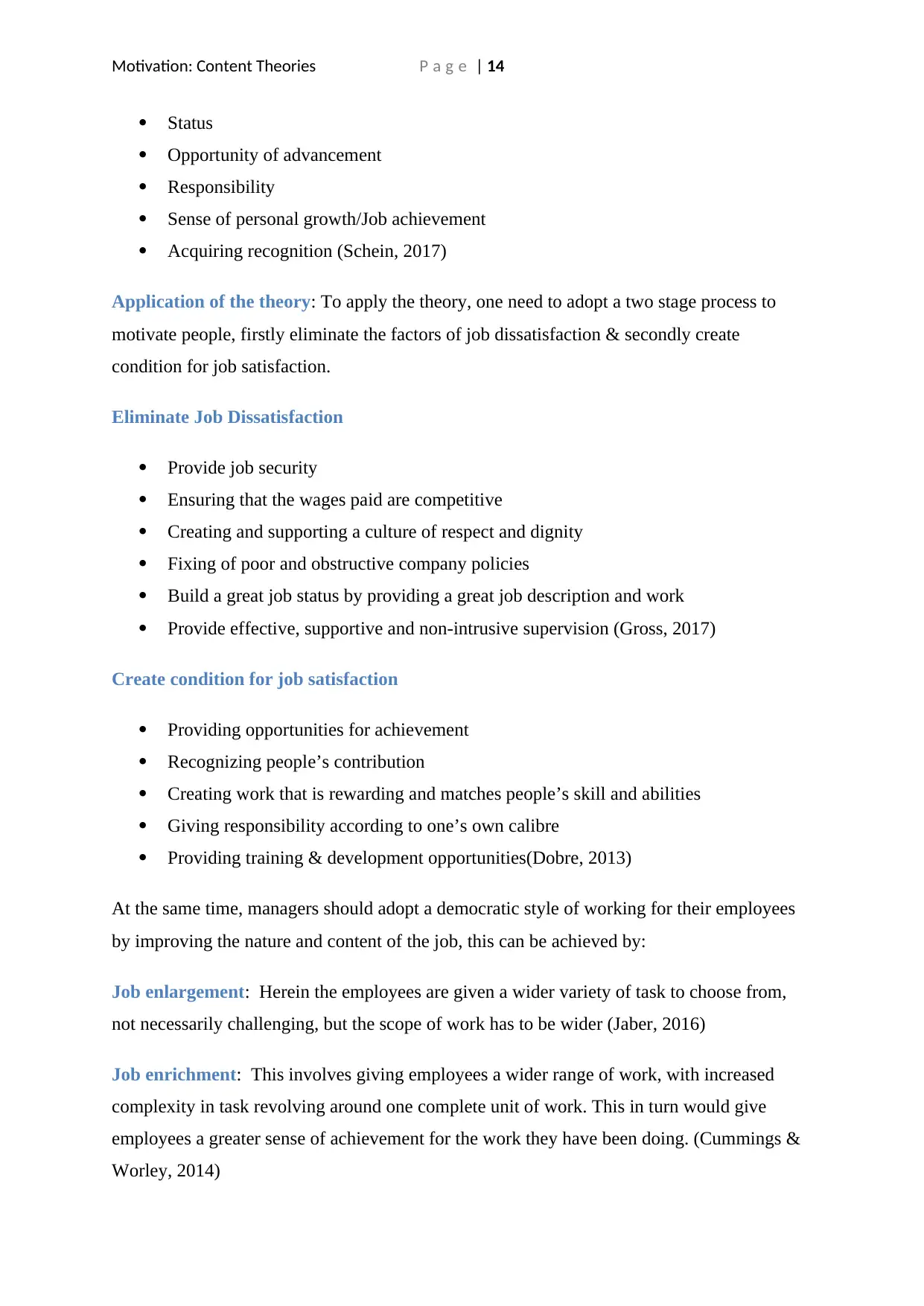
Motivation: Content Theories P a g e | 14
Status
Opportunity of advancement
Responsibility
Sense of personal growth/Job achievement
Acquiring recognition (Schein, 2017)
Application of the theory: To apply the theory, one need to adopt a two stage process to
motivate people, firstly eliminate the factors of job dissatisfaction & secondly create
condition for job satisfaction.
Eliminate Job Dissatisfaction
Provide job security
Ensuring that the wages paid are competitive
Creating and supporting a culture of respect and dignity
Fixing of poor and obstructive company policies
Build a great job status by providing a great job description and work
Provide effective, supportive and non-intrusive supervision (Gross, 2017)
Create condition for job satisfaction
Providing opportunities for achievement
Recognizing people’s contribution
Creating work that is rewarding and matches people’s skill and abilities
Giving responsibility according to one’s own calibre
Providing training & development opportunities(Dobre, 2013)
At the same time, managers should adopt a democratic style of working for their employees
by improving the nature and content of the job, this can be achieved by:
Job enlargement: Herein the employees are given a wider variety of task to choose from,
not necessarily challenging, but the scope of work has to be wider (Jaber, 2016)
Job enrichment: This involves giving employees a wider range of work, with increased
complexity in task revolving around one complete unit of work. This in turn would give
employees a greater sense of achievement for the work they have been doing. (Cummings &
Worley, 2014)
Status
Opportunity of advancement
Responsibility
Sense of personal growth/Job achievement
Acquiring recognition (Schein, 2017)
Application of the theory: To apply the theory, one need to adopt a two stage process to
motivate people, firstly eliminate the factors of job dissatisfaction & secondly create
condition for job satisfaction.
Eliminate Job Dissatisfaction
Provide job security
Ensuring that the wages paid are competitive
Creating and supporting a culture of respect and dignity
Fixing of poor and obstructive company policies
Build a great job status by providing a great job description and work
Provide effective, supportive and non-intrusive supervision (Gross, 2017)
Create condition for job satisfaction
Providing opportunities for achievement
Recognizing people’s contribution
Creating work that is rewarding and matches people’s skill and abilities
Giving responsibility according to one’s own calibre
Providing training & development opportunities(Dobre, 2013)
At the same time, managers should adopt a democratic style of working for their employees
by improving the nature and content of the job, this can be achieved by:
Job enlargement: Herein the employees are given a wider variety of task to choose from,
not necessarily challenging, but the scope of work has to be wider (Jaber, 2016)
Job enrichment: This involves giving employees a wider range of work, with increased
complexity in task revolving around one complete unit of work. This in turn would give
employees a greater sense of achievement for the work they have been doing. (Cummings &
Worley, 2014)
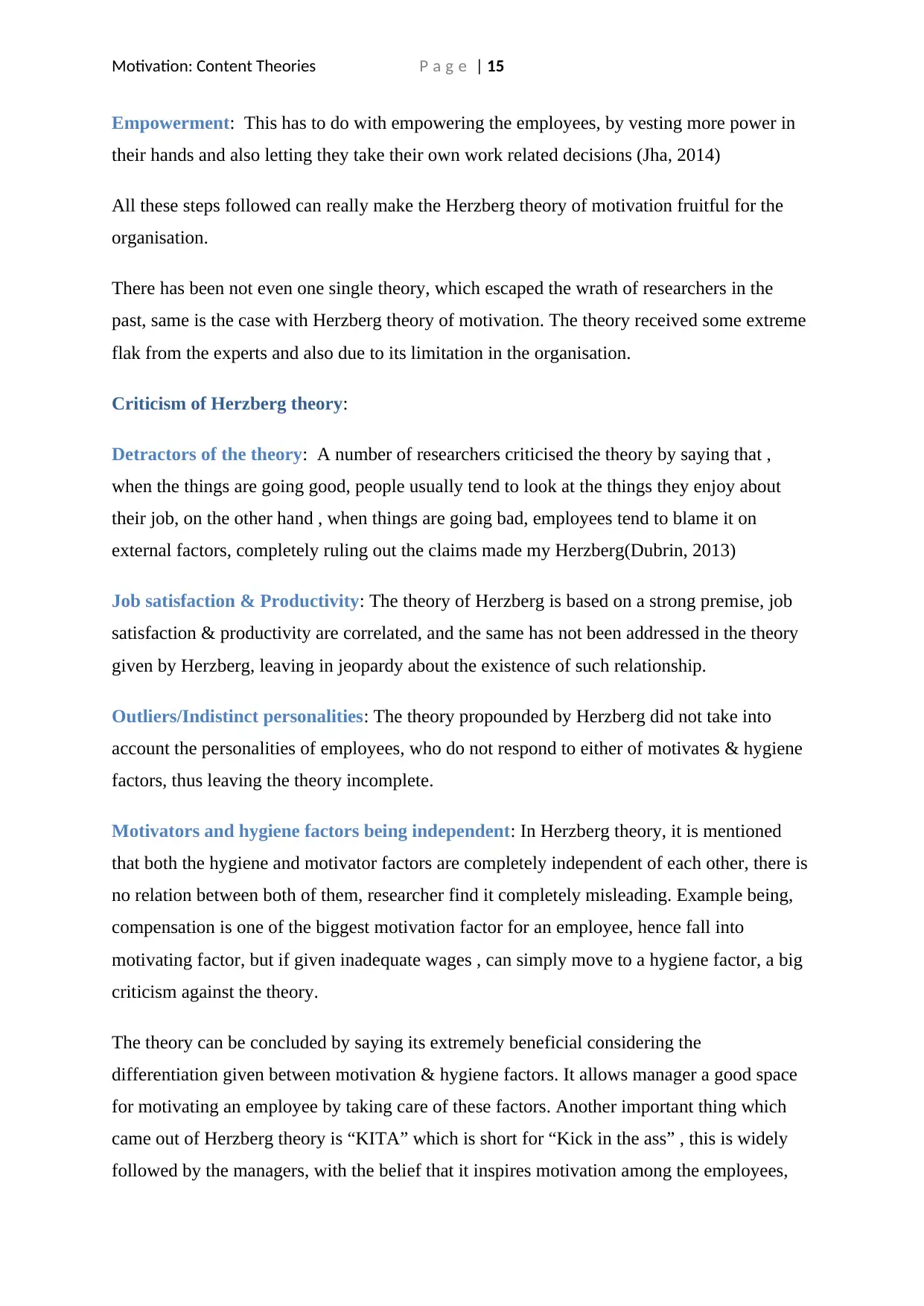
Motivation: Content Theories P a g e | 15
Empowerment: This has to do with empowering the employees, by vesting more power in
their hands and also letting they take their own work related decisions (Jha, 2014)
All these steps followed can really make the Herzberg theory of motivation fruitful for the
organisation.
There has been not even one single theory, which escaped the wrath of researchers in the
past, same is the case with Herzberg theory of motivation. The theory received some extreme
flak from the experts and also due to its limitation in the organisation.
Criticism of Herzberg theory:
Detractors of the theory: A number of researchers criticised the theory by saying that ,
when the things are going good, people usually tend to look at the things they enjoy about
their job, on the other hand , when things are going bad, employees tend to blame it on
external factors, completely ruling out the claims made my Herzberg(Dubrin, 2013)
Job satisfaction & Productivity: The theory of Herzberg is based on a strong premise, job
satisfaction & productivity are correlated, and the same has not been addressed in the theory
given by Herzberg, leaving in jeopardy about the existence of such relationship.
Outliers/Indistinct personalities: The theory propounded by Herzberg did not take into
account the personalities of employees, who do not respond to either of motivates & hygiene
factors, thus leaving the theory incomplete.
Motivators and hygiene factors being independent: In Herzberg theory, it is mentioned
that both the hygiene and motivator factors are completely independent of each other, there is
no relation between both of them, researcher find it completely misleading. Example being,
compensation is one of the biggest motivation factor for an employee, hence fall into
motivating factor, but if given inadequate wages , can simply move to a hygiene factor, a big
criticism against the theory.
The theory can be concluded by saying its extremely beneficial considering the
differentiation given between motivation & hygiene factors. It allows manager a good space
for motivating an employee by taking care of these factors. Another important thing which
came out of Herzberg theory is “KITA” which is short for “Kick in the ass” , this is widely
followed by the managers, with the belief that it inspires motivation among the employees,
Empowerment: This has to do with empowering the employees, by vesting more power in
their hands and also letting they take their own work related decisions (Jha, 2014)
All these steps followed can really make the Herzberg theory of motivation fruitful for the
organisation.
There has been not even one single theory, which escaped the wrath of researchers in the
past, same is the case with Herzberg theory of motivation. The theory received some extreme
flak from the experts and also due to its limitation in the organisation.
Criticism of Herzberg theory:
Detractors of the theory: A number of researchers criticised the theory by saying that ,
when the things are going good, people usually tend to look at the things they enjoy about
their job, on the other hand , when things are going bad, employees tend to blame it on
external factors, completely ruling out the claims made my Herzberg(Dubrin, 2013)
Job satisfaction & Productivity: The theory of Herzberg is based on a strong premise, job
satisfaction & productivity are correlated, and the same has not been addressed in the theory
given by Herzberg, leaving in jeopardy about the existence of such relationship.
Outliers/Indistinct personalities: The theory propounded by Herzberg did not take into
account the personalities of employees, who do not respond to either of motivates & hygiene
factors, thus leaving the theory incomplete.
Motivators and hygiene factors being independent: In Herzberg theory, it is mentioned
that both the hygiene and motivator factors are completely independent of each other, there is
no relation between both of them, researcher find it completely misleading. Example being,
compensation is one of the biggest motivation factor for an employee, hence fall into
motivating factor, but if given inadequate wages , can simply move to a hygiene factor, a big
criticism against the theory.
The theory can be concluded by saying its extremely beneficial considering the
differentiation given between motivation & hygiene factors. It allows manager a good space
for motivating an employee by taking care of these factors. Another important thing which
came out of Herzberg theory is “KITA” which is short for “Kick in the ass” , this is widely
followed by the managers, with the belief that it inspires motivation among the employees,
Secure Best Marks with AI Grader
Need help grading? Try our AI Grader for instant feedback on your assignments.
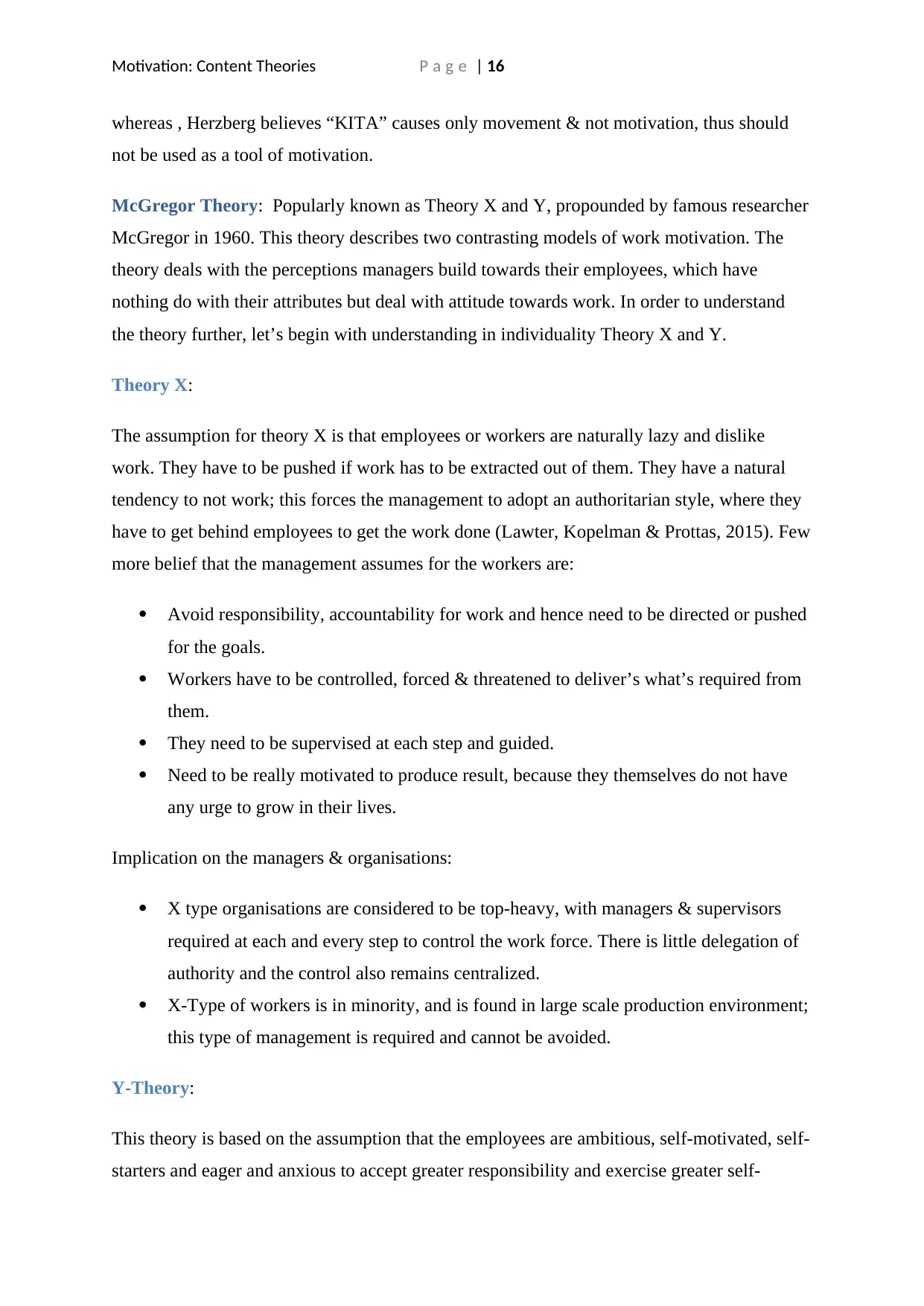
Motivation: Content Theories P a g e | 16
whereas , Herzberg believes “KITA” causes only movement & not motivation, thus should
not be used as a tool of motivation.
McGregor Theory: Popularly known as Theory X and Y, propounded by famous researcher
McGregor in 1960. This theory describes two contrasting models of work motivation. The
theory deals with the perceptions managers build towards their employees, which have
nothing do with their attributes but deal with attitude towards work. In order to understand
the theory further, let’s begin with understanding in individuality Theory X and Y.
Theory X:
The assumption for theory X is that employees or workers are naturally lazy and dislike
work. They have to be pushed if work has to be extracted out of them. They have a natural
tendency to not work; this forces the management to adopt an authoritarian style, where they
have to get behind employees to get the work done (Lawter, Kopelman & Prottas, 2015). Few
more belief that the management assumes for the workers are:
Avoid responsibility, accountability for work and hence need to be directed or pushed
for the goals.
Workers have to be controlled, forced & threatened to deliver’s what’s required from
them.
They need to be supervised at each step and guided.
Need to be really motivated to produce result, because they themselves do not have
any urge to grow in their lives.
Implication on the managers & organisations:
X type organisations are considered to be top-heavy, with managers & supervisors
required at each and every step to control the work force. There is little delegation of
authority and the control also remains centralized.
X-Type of workers is in minority, and is found in large scale production environment;
this type of management is required and cannot be avoided.
Y-Theory:
This theory is based on the assumption that the employees are ambitious, self-motivated, self-
starters and eager and anxious to accept greater responsibility and exercise greater self-
whereas , Herzberg believes “KITA” causes only movement & not motivation, thus should
not be used as a tool of motivation.
McGregor Theory: Popularly known as Theory X and Y, propounded by famous researcher
McGregor in 1960. This theory describes two contrasting models of work motivation. The
theory deals with the perceptions managers build towards their employees, which have
nothing do with their attributes but deal with attitude towards work. In order to understand
the theory further, let’s begin with understanding in individuality Theory X and Y.
Theory X:
The assumption for theory X is that employees or workers are naturally lazy and dislike
work. They have to be pushed if work has to be extracted out of them. They have a natural
tendency to not work; this forces the management to adopt an authoritarian style, where they
have to get behind employees to get the work done (Lawter, Kopelman & Prottas, 2015). Few
more belief that the management assumes for the workers are:
Avoid responsibility, accountability for work and hence need to be directed or pushed
for the goals.
Workers have to be controlled, forced & threatened to deliver’s what’s required from
them.
They need to be supervised at each step and guided.
Need to be really motivated to produce result, because they themselves do not have
any urge to grow in their lives.
Implication on the managers & organisations:
X type organisations are considered to be top-heavy, with managers & supervisors
required at each and every step to control the work force. There is little delegation of
authority and the control also remains centralized.
X-Type of workers is in minority, and is found in large scale production environment;
this type of management is required and cannot be avoided.
Y-Theory:
This theory is based on the assumption that the employees are ambitious, self-motivated, self-
starters and eager and anxious to accept greater responsibility and exercise greater self-
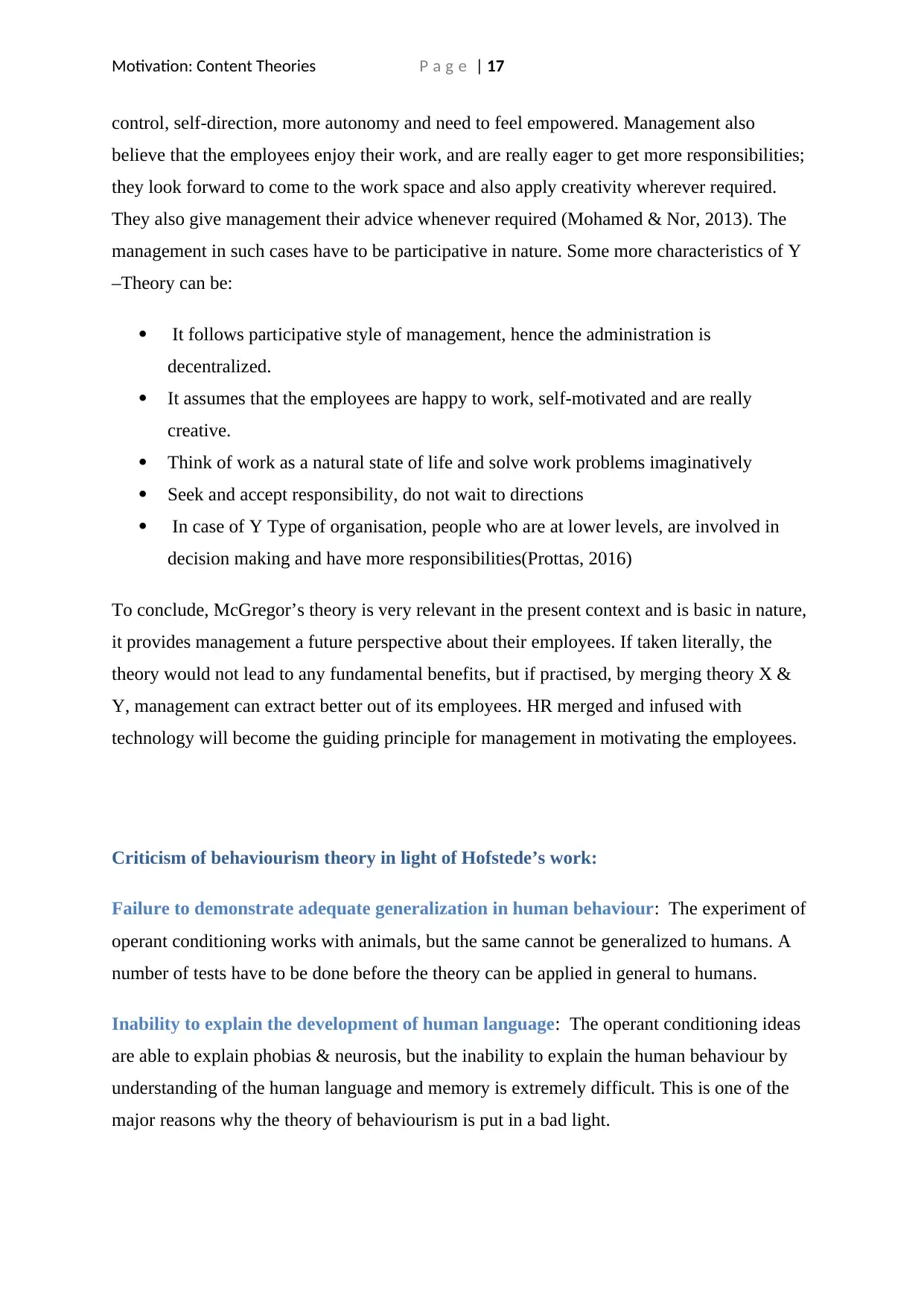
Motivation: Content Theories P a g e | 17
control, self-direction, more autonomy and need to feel empowered. Management also
believe that the employees enjoy their work, and are really eager to get more responsibilities;
they look forward to come to the work space and also apply creativity wherever required.
They also give management their advice whenever required (Mohamed & Nor, 2013). The
management in such cases have to be participative in nature. Some more characteristics of Y
–Theory can be:
It follows participative style of management, hence the administration is
decentralized.
It assumes that the employees are happy to work, self-motivated and are really
creative.
Think of work as a natural state of life and solve work problems imaginatively
Seek and accept responsibility, do not wait to directions
In case of Y Type of organisation, people who are at lower levels, are involved in
decision making and have more responsibilities(Prottas, 2016)
To conclude, McGregor’s theory is very relevant in the present context and is basic in nature,
it provides management a future perspective about their employees. If taken literally, the
theory would not lead to any fundamental benefits, but if practised, by merging theory X &
Y, management can extract better out of its employees. HR merged and infused with
technology will become the guiding principle for management in motivating the employees.
Criticism of behaviourism theory in light of Hofstede’s work:
Failure to demonstrate adequate generalization in human behaviour: The experiment of
operant conditioning works with animals, but the same cannot be generalized to humans. A
number of tests have to be done before the theory can be applied in general to humans.
Inability to explain the development of human language: The operant conditioning ideas
are able to explain phobias & neurosis, but the inability to explain the human behaviour by
understanding of the human language and memory is extremely difficult. This is one of the
major reasons why the theory of behaviourism is put in a bad light.
control, self-direction, more autonomy and need to feel empowered. Management also
believe that the employees enjoy their work, and are really eager to get more responsibilities;
they look forward to come to the work space and also apply creativity wherever required.
They also give management their advice whenever required (Mohamed & Nor, 2013). The
management in such cases have to be participative in nature. Some more characteristics of Y
–Theory can be:
It follows participative style of management, hence the administration is
decentralized.
It assumes that the employees are happy to work, self-motivated and are really
creative.
Think of work as a natural state of life and solve work problems imaginatively
Seek and accept responsibility, do not wait to directions
In case of Y Type of organisation, people who are at lower levels, are involved in
decision making and have more responsibilities(Prottas, 2016)
To conclude, McGregor’s theory is very relevant in the present context and is basic in nature,
it provides management a future perspective about their employees. If taken literally, the
theory would not lead to any fundamental benefits, but if practised, by merging theory X &
Y, management can extract better out of its employees. HR merged and infused with
technology will become the guiding principle for management in motivating the employees.
Criticism of behaviourism theory in light of Hofstede’s work:
Failure to demonstrate adequate generalization in human behaviour: The experiment of
operant conditioning works with animals, but the same cannot be generalized to humans. A
number of tests have to be done before the theory can be applied in general to humans.
Inability to explain the development of human language: The operant conditioning ideas
are able to explain phobias & neurosis, but the inability to explain the human behaviour by
understanding of the human language and memory is extremely difficult. This is one of the
major reasons why the theory of behaviourism is put in a bad light.
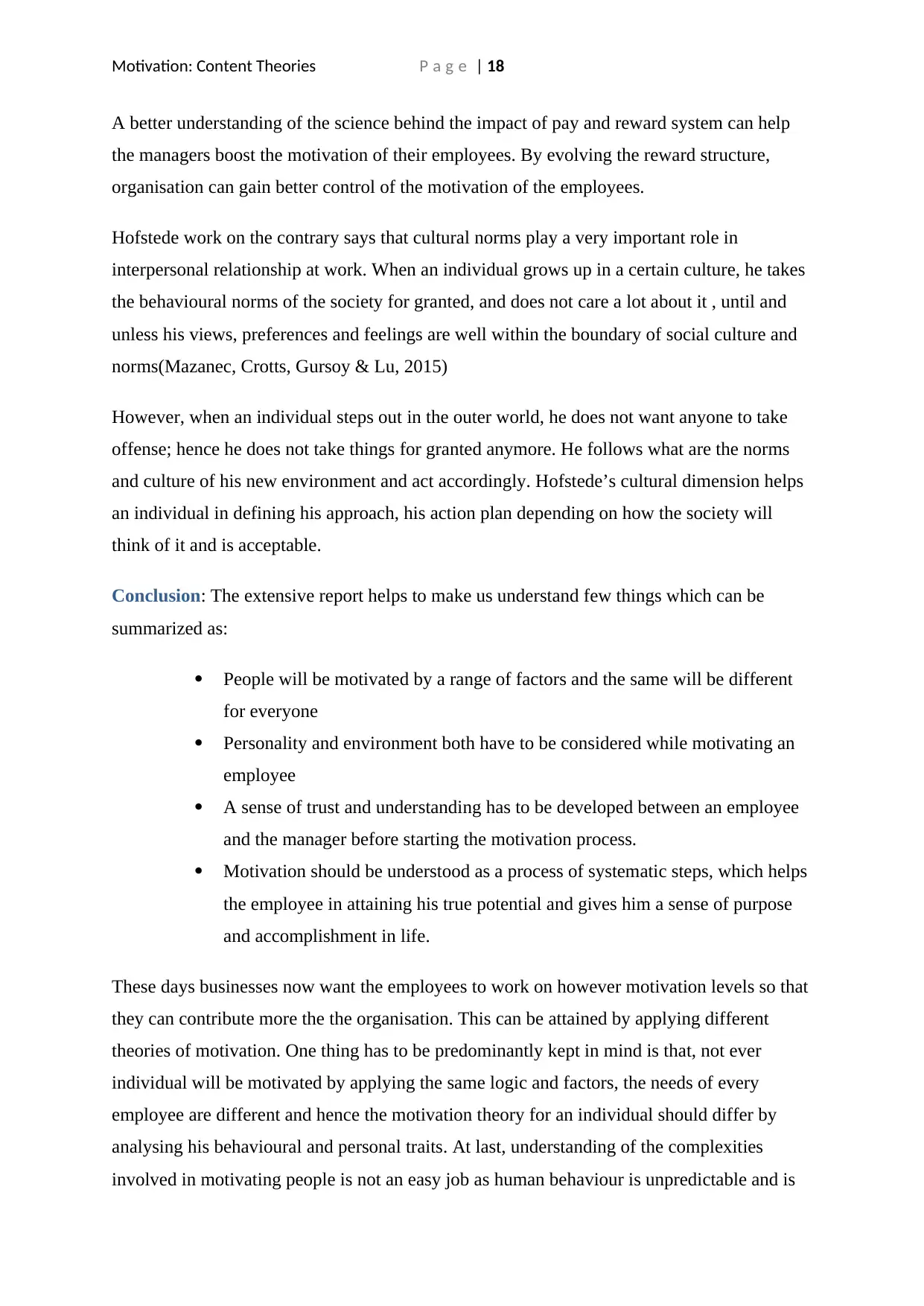
Motivation: Content Theories P a g e | 18
A better understanding of the science behind the impact of pay and reward system can help
the managers boost the motivation of their employees. By evolving the reward structure,
organisation can gain better control of the motivation of the employees.
Hofstede work on the contrary says that cultural norms play a very important role in
interpersonal relationship at work. When an individual grows up in a certain culture, he takes
the behavioural norms of the society for granted, and does not care a lot about it , until and
unless his views, preferences and feelings are well within the boundary of social culture and
norms(Mazanec, Crotts, Gursoy & Lu, 2015)
However, when an individual steps out in the outer world, he does not want anyone to take
offense; hence he does not take things for granted anymore. He follows what are the norms
and culture of his new environment and act accordingly. Hofstede’s cultural dimension helps
an individual in defining his approach, his action plan depending on how the society will
think of it and is acceptable.
Conclusion: The extensive report helps to make us understand few things which can be
summarized as:
People will be motivated by a range of factors and the same will be different
for everyone
Personality and environment both have to be considered while motivating an
employee
A sense of trust and understanding has to be developed between an employee
and the manager before starting the motivation process.
Motivation should be understood as a process of systematic steps, which helps
the employee in attaining his true potential and gives him a sense of purpose
and accomplishment in life.
These days businesses now want the employees to work on however motivation levels so that
they can contribute more the the organisation. This can be attained by applying different
theories of motivation. One thing has to be predominantly kept in mind is that, not ever
individual will be motivated by applying the same logic and factors, the needs of every
employee are different and hence the motivation theory for an individual should differ by
analysing his behavioural and personal traits. At last, understanding of the complexities
involved in motivating people is not an easy job as human behaviour is unpredictable and is
A better understanding of the science behind the impact of pay and reward system can help
the managers boost the motivation of their employees. By evolving the reward structure,
organisation can gain better control of the motivation of the employees.
Hofstede work on the contrary says that cultural norms play a very important role in
interpersonal relationship at work. When an individual grows up in a certain culture, he takes
the behavioural norms of the society for granted, and does not care a lot about it , until and
unless his views, preferences and feelings are well within the boundary of social culture and
norms(Mazanec, Crotts, Gursoy & Lu, 2015)
However, when an individual steps out in the outer world, he does not want anyone to take
offense; hence he does not take things for granted anymore. He follows what are the norms
and culture of his new environment and act accordingly. Hofstede’s cultural dimension helps
an individual in defining his approach, his action plan depending on how the society will
think of it and is acceptable.
Conclusion: The extensive report helps to make us understand few things which can be
summarized as:
People will be motivated by a range of factors and the same will be different
for everyone
Personality and environment both have to be considered while motivating an
employee
A sense of trust and understanding has to be developed between an employee
and the manager before starting the motivation process.
Motivation should be understood as a process of systematic steps, which helps
the employee in attaining his true potential and gives him a sense of purpose
and accomplishment in life.
These days businesses now want the employees to work on however motivation levels so that
they can contribute more the the organisation. This can be attained by applying different
theories of motivation. One thing has to be predominantly kept in mind is that, not ever
individual will be motivated by applying the same logic and factors, the needs of every
employee are different and hence the motivation theory for an individual should differ by
analysing his behavioural and personal traits. At last, understanding of the complexities
involved in motivating people is not an easy job as human behaviour is unpredictable and is
Paraphrase This Document
Need a fresh take? Get an instant paraphrase of this document with our AI Paraphraser
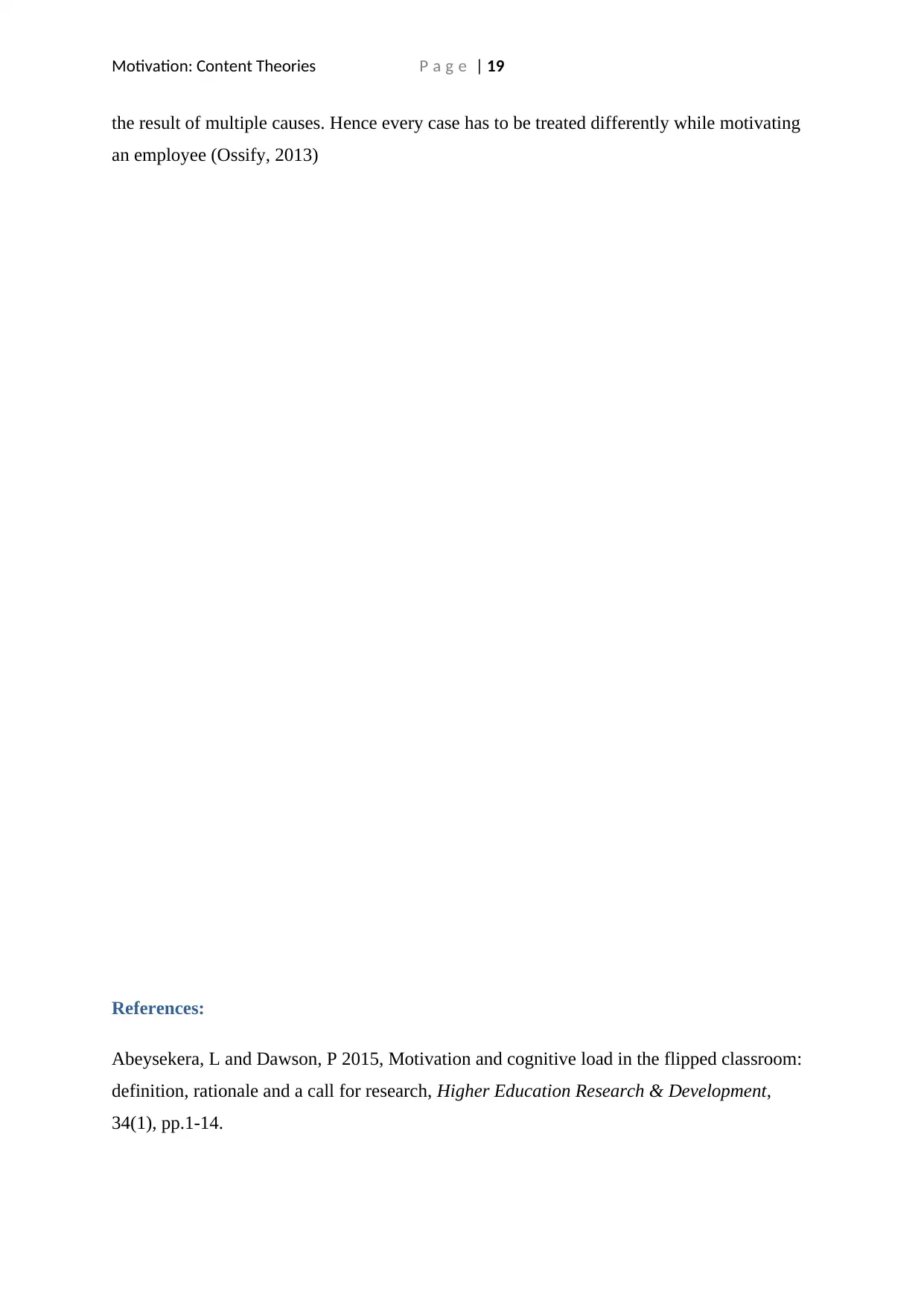
Motivation: Content Theories P a g e | 19
the result of multiple causes. Hence every case has to be treated differently while motivating
an employee (Ossify, 2013)
References:
Abeysekera, L and Dawson, P 2015, Motivation and cognitive load in the flipped classroom:
definition, rationale and a call for research, Higher Education Research & Development,
34(1), pp.1-14.
the result of multiple causes. Hence every case has to be treated differently while motivating
an employee (Ossify, 2013)
References:
Abeysekera, L and Dawson, P 2015, Motivation and cognitive load in the flipped classroom:
definition, rationale and a call for research, Higher Education Research & Development,
34(1), pp.1-14.
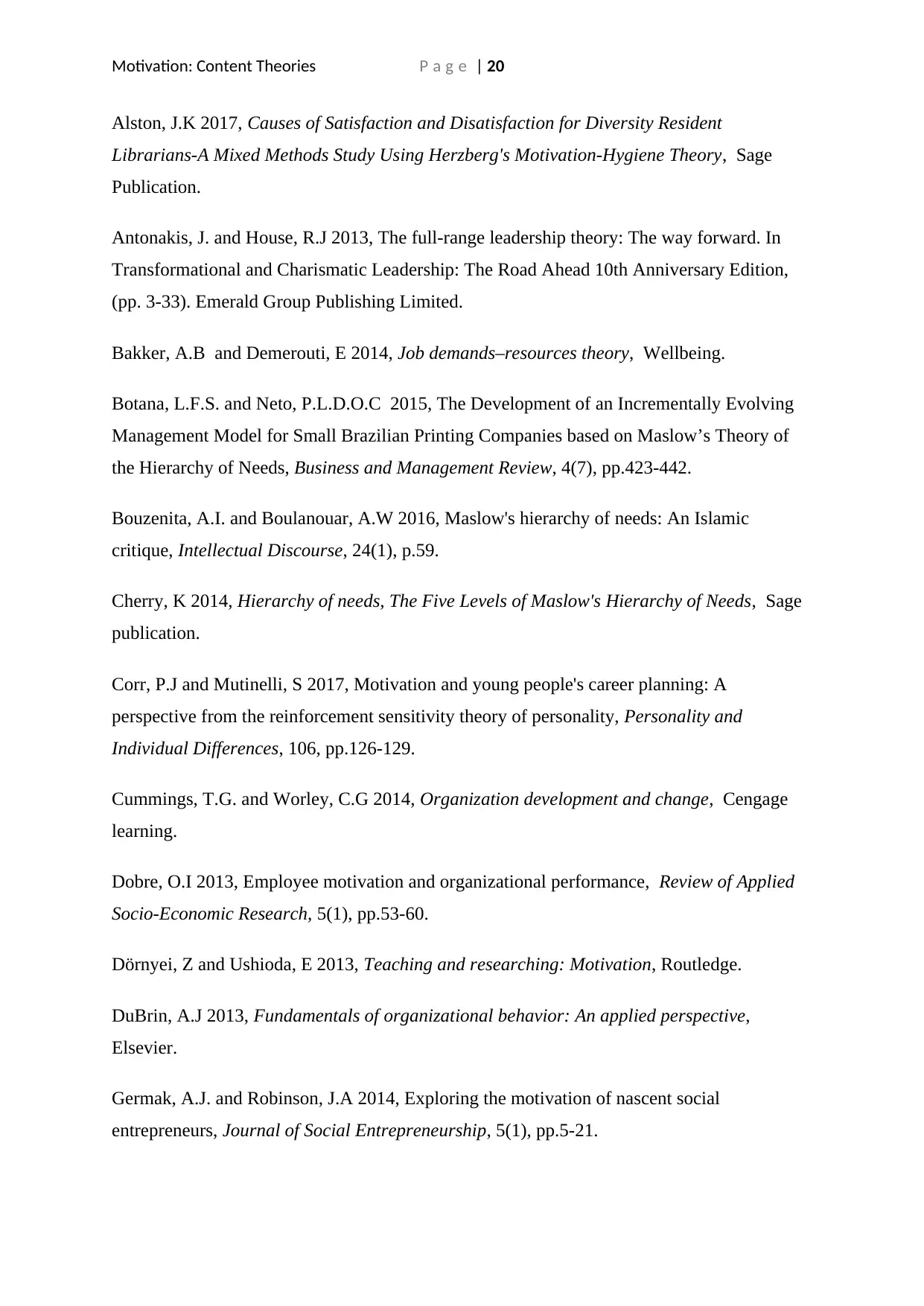
Motivation: Content Theories P a g e | 20
Alston, J.K 2017, Causes of Satisfaction and Disatisfaction for Diversity Resident
Librarians-A Mixed Methods Study Using Herzberg's Motivation-Hygiene Theory, Sage
Publication.
Antonakis, J. and House, R.J 2013, The full-range leadership theory: The way forward. In
Transformational and Charismatic Leadership: The Road Ahead 10th Anniversary Edition,
(pp. 3-33). Emerald Group Publishing Limited.
Bakker, A.B and Demerouti, E 2014, Job demands–resources theory, Wellbeing.
Botana, L.F.S. and Neto, P.L.D.O.C 2015, The Development of an Incrementally Evolving
Management Model for Small Brazilian Printing Companies based on Maslow’s Theory of
the Hierarchy of Needs, Business and Management Review, 4(7), pp.423-442.
Bouzenita, A.I. and Boulanouar, A.W 2016, Maslow's hierarchy of needs: An Islamic
critique, Intellectual Discourse, 24(1), p.59.
Cherry, K 2014, Hierarchy of needs, The Five Levels of Maslow's Hierarchy of Needs, Sage
publication.
Corr, P.J and Mutinelli, S 2017, Motivation and young people's career planning: A
perspective from the reinforcement sensitivity theory of personality, Personality and
Individual Differences, 106, pp.126-129.
Cummings, T.G. and Worley, C.G 2014, Organization development and change, Cengage
learning.
Dobre, O.I 2013, Employee motivation and organizational performance, Review of Applied
Socio-Economic Research, 5(1), pp.53-60.
Dörnyei, Z and Ushioda, E 2013, Teaching and researching: Motivation, Routledge.
DuBrin, A.J 2013, Fundamentals of organizational behavior: An applied perspective,
Elsevier.
Germak, A.J. and Robinson, J.A 2014, Exploring the motivation of nascent social
entrepreneurs, Journal of Social Entrepreneurship, 5(1), pp.5-21.
Alston, J.K 2017, Causes of Satisfaction and Disatisfaction for Diversity Resident
Librarians-A Mixed Methods Study Using Herzberg's Motivation-Hygiene Theory, Sage
Publication.
Antonakis, J. and House, R.J 2013, The full-range leadership theory: The way forward. In
Transformational and Charismatic Leadership: The Road Ahead 10th Anniversary Edition,
(pp. 3-33). Emerald Group Publishing Limited.
Bakker, A.B and Demerouti, E 2014, Job demands–resources theory, Wellbeing.
Botana, L.F.S. and Neto, P.L.D.O.C 2015, The Development of an Incrementally Evolving
Management Model for Small Brazilian Printing Companies based on Maslow’s Theory of
the Hierarchy of Needs, Business and Management Review, 4(7), pp.423-442.
Bouzenita, A.I. and Boulanouar, A.W 2016, Maslow's hierarchy of needs: An Islamic
critique, Intellectual Discourse, 24(1), p.59.
Cherry, K 2014, Hierarchy of needs, The Five Levels of Maslow's Hierarchy of Needs, Sage
publication.
Corr, P.J and Mutinelli, S 2017, Motivation and young people's career planning: A
perspective from the reinforcement sensitivity theory of personality, Personality and
Individual Differences, 106, pp.126-129.
Cummings, T.G. and Worley, C.G 2014, Organization development and change, Cengage
learning.
Dobre, O.I 2013, Employee motivation and organizational performance, Review of Applied
Socio-Economic Research, 5(1), pp.53-60.
Dörnyei, Z and Ushioda, E 2013, Teaching and researching: Motivation, Routledge.
DuBrin, A.J 2013, Fundamentals of organizational behavior: An applied perspective,
Elsevier.
Germak, A.J. and Robinson, J.A 2014, Exploring the motivation of nascent social
entrepreneurs, Journal of Social Entrepreneurship, 5(1), pp.5-21.
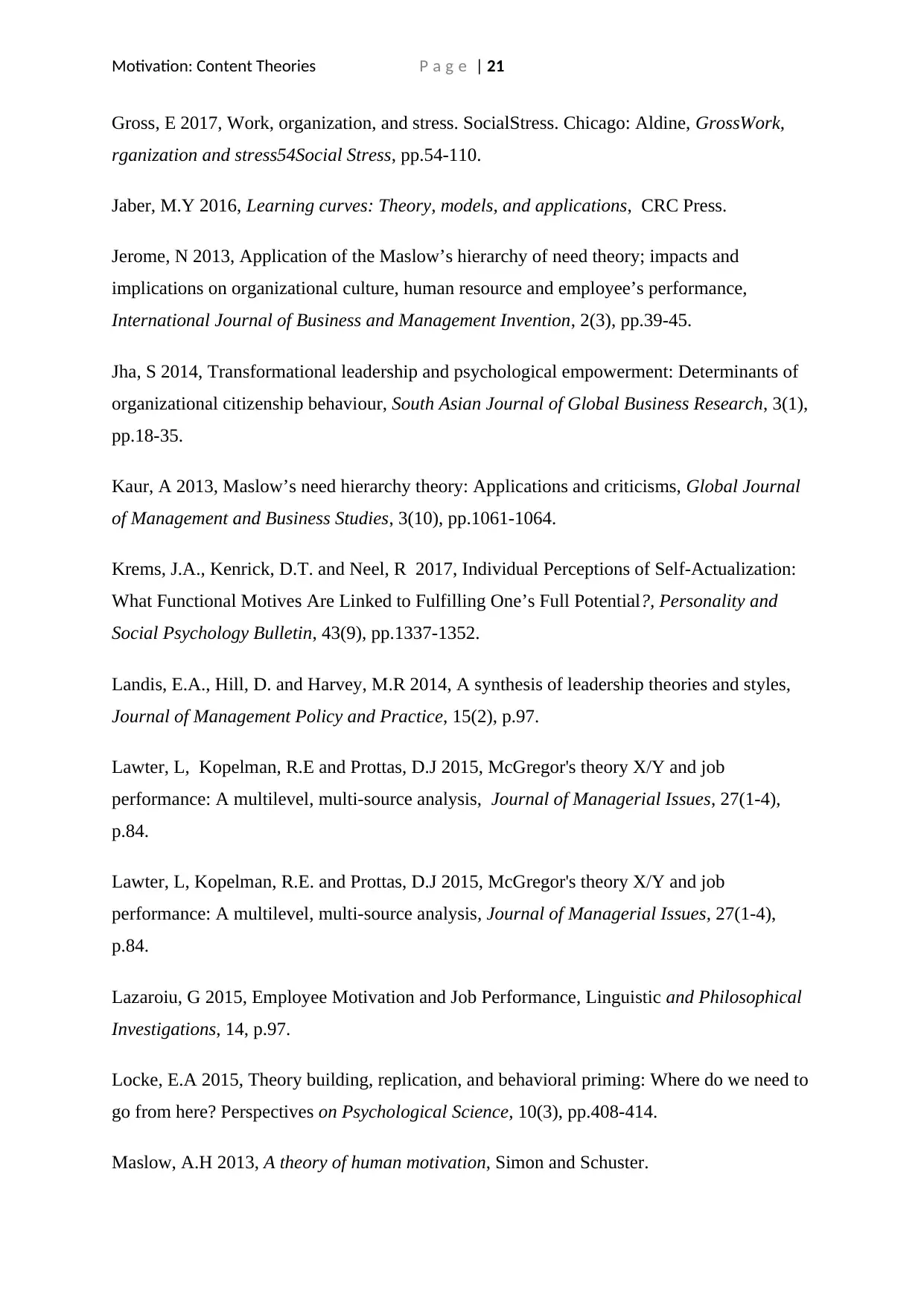
Motivation: Content Theories P a g e | 21
Gross, E 2017, Work, organization, and stress. SocialStress. Chicago: Aldine, GrossWork,
rganization and stress54Social Stress, pp.54-110.
Jaber, M.Y 2016, Learning curves: Theory, models, and applications, CRC Press.
Jerome, N 2013, Application of the Maslow’s hierarchy of need theory; impacts and
implications on organizational culture, human resource and employee’s performance,
International Journal of Business and Management Invention, 2(3), pp.39-45.
Jha, S 2014, Transformational leadership and psychological empowerment: Determinants of
organizational citizenship behaviour, South Asian Journal of Global Business Research, 3(1),
pp.18-35.
Kaur, A 2013, Maslow’s need hierarchy theory: Applications and criticisms, Global Journal
of Management and Business Studies, 3(10), pp.1061-1064.
Krems, J.A., Kenrick, D.T. and Neel, R 2017, Individual Perceptions of Self-Actualization:
What Functional Motives Are Linked to Fulfilling One’s Full Potential?, Personality and
Social Psychology Bulletin, 43(9), pp.1337-1352.
Landis, E.A., Hill, D. and Harvey, M.R 2014, A synthesis of leadership theories and styles,
Journal of Management Policy and Practice, 15(2), p.97.
Lawter, L, Kopelman, R.E and Prottas, D.J 2015, McGregor's theory X/Y and job
performance: A multilevel, multi-source analysis, Journal of Managerial Issues, 27(1-4),
p.84.
Lawter, L, Kopelman, R.E. and Prottas, D.J 2015, McGregor's theory X/Y and job
performance: A multilevel, multi-source analysis, Journal of Managerial Issues, 27(1-4),
p.84.
Lazaroiu, G 2015, Employee Motivation and Job Performance, Linguistic and Philosophical
Investigations, 14, p.97.
Locke, E.A 2015, Theory building, replication, and behavioral priming: Where do we need to
go from here? Perspectives on Psychological Science, 10(3), pp.408-414.
Maslow, A.H 2013, A theory of human motivation, Simon and Schuster.
Gross, E 2017, Work, organization, and stress. SocialStress. Chicago: Aldine, GrossWork,
rganization and stress54Social Stress, pp.54-110.
Jaber, M.Y 2016, Learning curves: Theory, models, and applications, CRC Press.
Jerome, N 2013, Application of the Maslow’s hierarchy of need theory; impacts and
implications on organizational culture, human resource and employee’s performance,
International Journal of Business and Management Invention, 2(3), pp.39-45.
Jha, S 2014, Transformational leadership and psychological empowerment: Determinants of
organizational citizenship behaviour, South Asian Journal of Global Business Research, 3(1),
pp.18-35.
Kaur, A 2013, Maslow’s need hierarchy theory: Applications and criticisms, Global Journal
of Management and Business Studies, 3(10), pp.1061-1064.
Krems, J.A., Kenrick, D.T. and Neel, R 2017, Individual Perceptions of Self-Actualization:
What Functional Motives Are Linked to Fulfilling One’s Full Potential?, Personality and
Social Psychology Bulletin, 43(9), pp.1337-1352.
Landis, E.A., Hill, D. and Harvey, M.R 2014, A synthesis of leadership theories and styles,
Journal of Management Policy and Practice, 15(2), p.97.
Lawter, L, Kopelman, R.E and Prottas, D.J 2015, McGregor's theory X/Y and job
performance: A multilevel, multi-source analysis, Journal of Managerial Issues, 27(1-4),
p.84.
Lawter, L, Kopelman, R.E. and Prottas, D.J 2015, McGregor's theory X/Y and job
performance: A multilevel, multi-source analysis, Journal of Managerial Issues, 27(1-4),
p.84.
Lazaroiu, G 2015, Employee Motivation and Job Performance, Linguistic and Philosophical
Investigations, 14, p.97.
Locke, E.A 2015, Theory building, replication, and behavioral priming: Where do we need to
go from here? Perspectives on Psychological Science, 10(3), pp.408-414.
Maslow, A.H 2013, A theory of human motivation, Simon and Schuster.
Secure Best Marks with AI Grader
Need help grading? Try our AI Grader for instant feedback on your assignments.
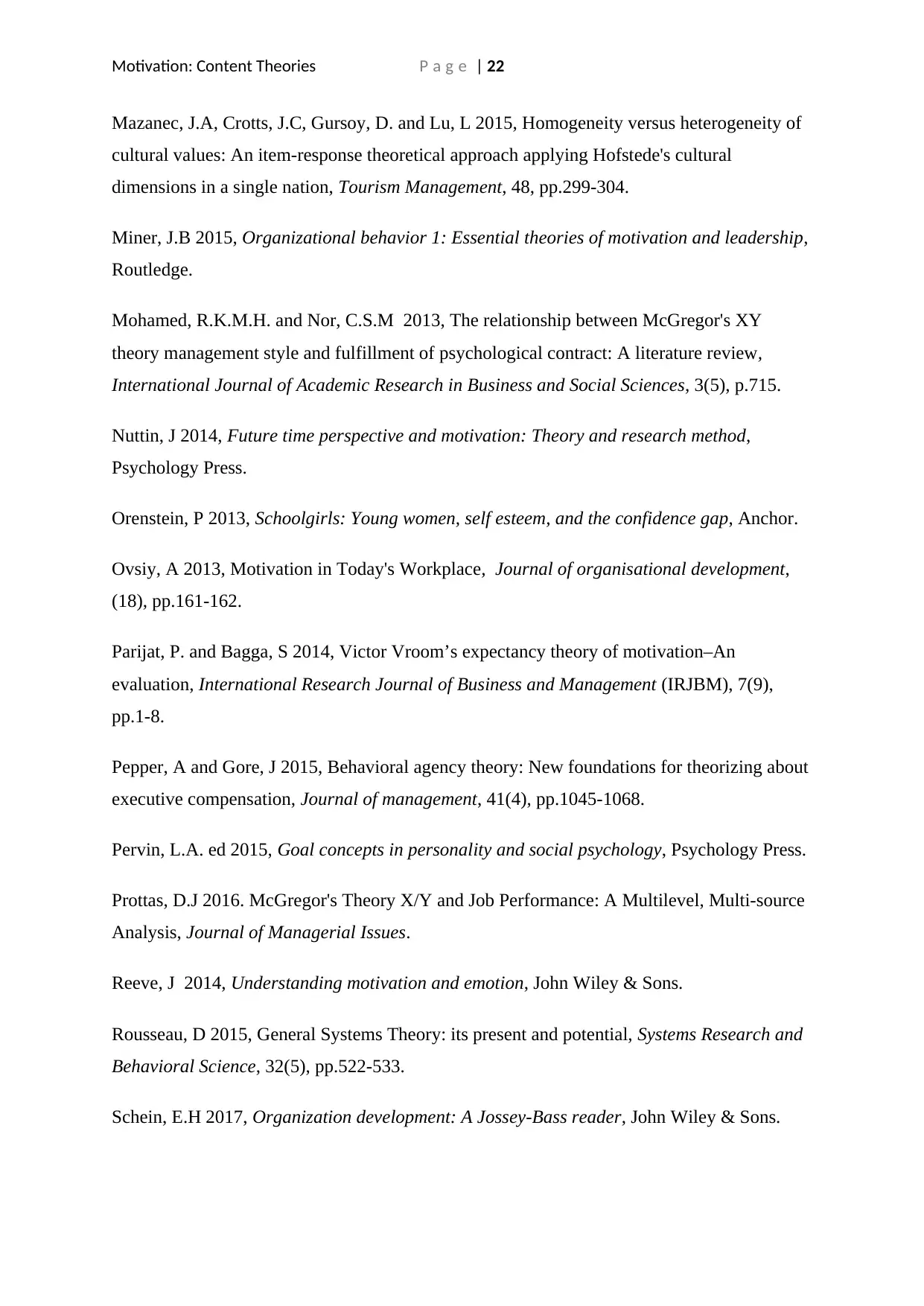
Motivation: Content Theories P a g e | 22
Mazanec, J.A, Crotts, J.C, Gursoy, D. and Lu, L 2015, Homogeneity versus heterogeneity of
cultural values: An item-response theoretical approach applying Hofstede's cultural
dimensions in a single nation, Tourism Management, 48, pp.299-304.
Miner, J.B 2015, Organizational behavior 1: Essential theories of motivation and leadership,
Routledge.
Mohamed, R.K.M.H. and Nor, C.S.M 2013, The relationship between McGregor's XY
theory management style and fulfillment of psychological contract: A literature review,
International Journal of Academic Research in Business and Social Sciences, 3(5), p.715.
Nuttin, J 2014, Future time perspective and motivation: Theory and research method,
Psychology Press.
Orenstein, P 2013, Schoolgirls: Young women, self esteem, and the confidence gap, Anchor.
Ovsiy, A 2013, Motivation in Today's Workplace, Journal of organisational development,
(18), pp.161-162.
Parijat, P. and Bagga, S 2014, Victor Vroom’s expectancy theory of motivation–An
evaluation, International Research Journal of Business and Management (IRJBM), 7(9),
pp.1-8.
Pepper, A and Gore, J 2015, Behavioral agency theory: New foundations for theorizing about
executive compensation, Journal of management, 41(4), pp.1045-1068.
Pervin, L.A. ed 2015, Goal concepts in personality and social psychology, Psychology Press.
Prottas, D.J 2016. McGregor's Theory X/Y and Job Performance: A Multilevel, Multi-source
Analysis, Journal of Managerial Issues.
Reeve, J 2014, Understanding motivation and emotion, John Wiley & Sons.
Rousseau, D 2015, General Systems Theory: its present and potential, Systems Research and
Behavioral Science, 32(5), pp.522-533.
Schein, E.H 2017, Organization development: A Jossey-Bass reader, John Wiley & Sons.
Mazanec, J.A, Crotts, J.C, Gursoy, D. and Lu, L 2015, Homogeneity versus heterogeneity of
cultural values: An item-response theoretical approach applying Hofstede's cultural
dimensions in a single nation, Tourism Management, 48, pp.299-304.
Miner, J.B 2015, Organizational behavior 1: Essential theories of motivation and leadership,
Routledge.
Mohamed, R.K.M.H. and Nor, C.S.M 2013, The relationship between McGregor's XY
theory management style and fulfillment of psychological contract: A literature review,
International Journal of Academic Research in Business and Social Sciences, 3(5), p.715.
Nuttin, J 2014, Future time perspective and motivation: Theory and research method,
Psychology Press.
Orenstein, P 2013, Schoolgirls: Young women, self esteem, and the confidence gap, Anchor.
Ovsiy, A 2013, Motivation in Today's Workplace, Journal of organisational development,
(18), pp.161-162.
Parijat, P. and Bagga, S 2014, Victor Vroom’s expectancy theory of motivation–An
evaluation, International Research Journal of Business and Management (IRJBM), 7(9),
pp.1-8.
Pepper, A and Gore, J 2015, Behavioral agency theory: New foundations for theorizing about
executive compensation, Journal of management, 41(4), pp.1045-1068.
Pervin, L.A. ed 2015, Goal concepts in personality and social psychology, Psychology Press.
Prottas, D.J 2016. McGregor's Theory X/Y and Job Performance: A Multilevel, Multi-source
Analysis, Journal of Managerial Issues.
Reeve, J 2014, Understanding motivation and emotion, John Wiley & Sons.
Rousseau, D 2015, General Systems Theory: its present and potential, Systems Research and
Behavioral Science, 32(5), pp.522-533.
Schein, E.H 2017, Organization development: A Jossey-Bass reader, John Wiley & Sons.
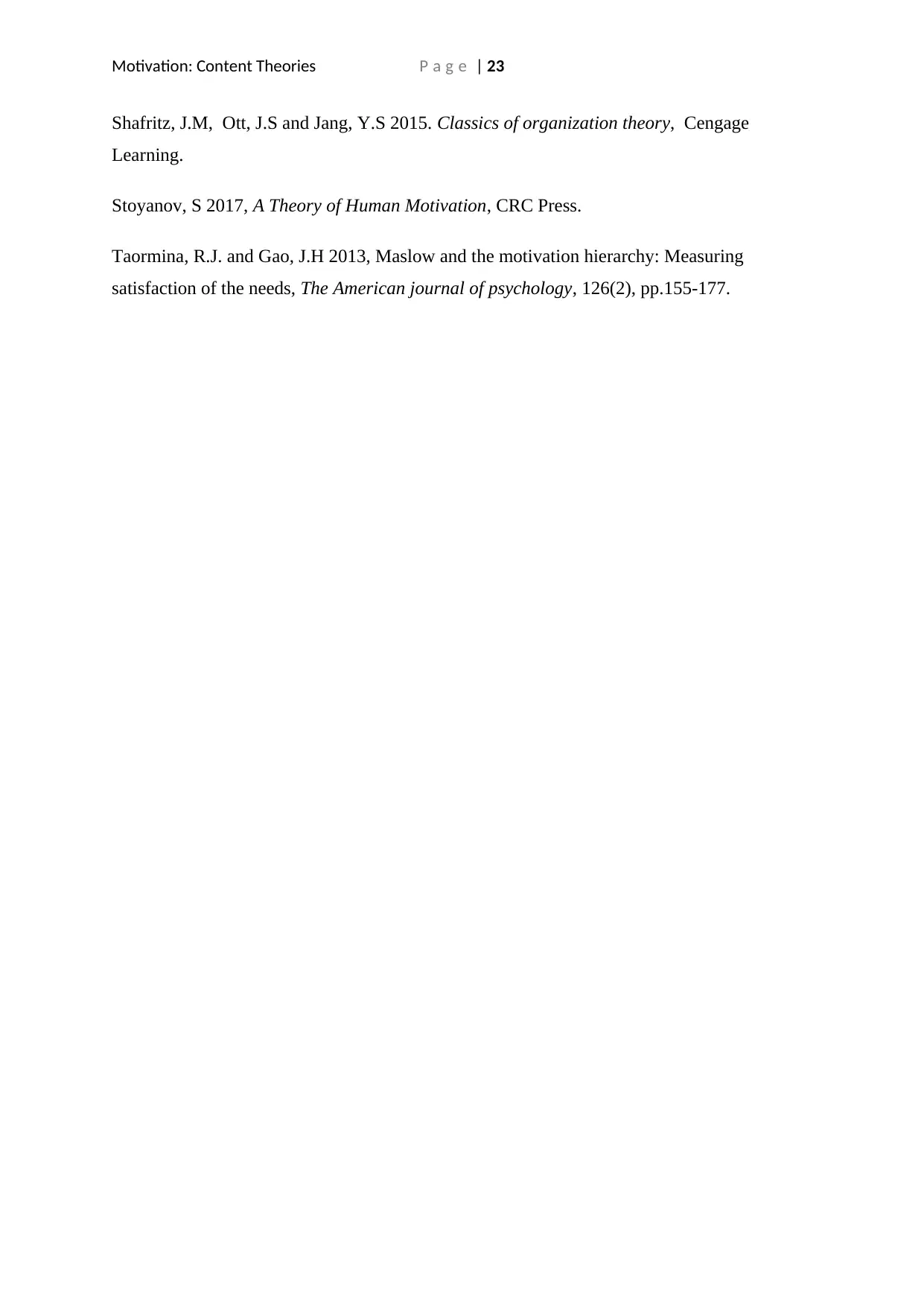
Motivation: Content Theories P a g e | 23
Shafritz, J.M, Ott, J.S and Jang, Y.S 2015. Classics of organization theory, Cengage
Learning.
Stoyanov, S 2017, A Theory of Human Motivation, CRC Press.
Taormina, R.J. and Gao, J.H 2013, Maslow and the motivation hierarchy: Measuring
satisfaction of the needs, The American journal of psychology, 126(2), pp.155-177.
Shafritz, J.M, Ott, J.S and Jang, Y.S 2015. Classics of organization theory, Cengage
Learning.
Stoyanov, S 2017, A Theory of Human Motivation, CRC Press.
Taormina, R.J. and Gao, J.H 2013, Maslow and the motivation hierarchy: Measuring
satisfaction of the needs, The American journal of psychology, 126(2), pp.155-177.
1 out of 24
Related Documents
Your All-in-One AI-Powered Toolkit for Academic Success.
+13062052269
info@desklib.com
Available 24*7 on WhatsApp / Email
![[object Object]](/_next/static/media/star-bottom.7253800d.svg)
Unlock your academic potential
© 2024 | Zucol Services PVT LTD | All rights reserved.





